SEO Content Strategy: Discovering What Your Audience Wants via @sejournal, @CallRail
Discover the latest trends, tips, and strategies in SEO and PPC marketing. Our curated articles offer in-depth analysis, practical advice, and actionable insights to elevate your digital marketing efforts. The post SEO Content Strategy: Discovering What Your Audience Wants...



Creating content that converts is a goal of every search marketer. Although producing content that draws in customers can be a challenge, it gets easier by adhering to some key principles.
Once you get to know your target audience through data analysis, you can create content that ranks, bring in more users, and increase your brand’s visibility.
There are many factors that go into a successful content strategy:
Staying ahead of the curve when search algorithms and user behavior change Creating high-quality content that meets user needs and aligns with search intent Facilitating the journey from early-stage prospect to repeat customer with content mappingThese are the principles we tackle in this collection of articles. We know it can be tough to create a content strategy that works in a world of shifting customer needs, so we’ve broken it down into manageable steps, with plenty of data-driven insights along the way.
You’ll especially like the insights in “Data-Driven Content Strategy: Boost Google Rankings With Real Audience Insights”, which gives actionable tips for using first- and zero-party data so you can plan results-driven content.
Until next time!

Katie Morton Editor in Chief, Search Engine Journal
How People Search: Understanding User Intent
Get insights into the importance of understanding user intent for effective SEO. Learn how Google's algorithms prioritize relevant content.
![]() Dan Taylor
66K Reads
Dan Taylor
66K Reads

In its earlier days, Google relied heavily on plain text data and backlinks to establish rankings through periodic monthly refreshes (then known as the Google Dance).
Since those days, Google Search has become a sophisticated product with a plethora of algorithms designed to promote content and results that meet a user’s needs.
To a certain extent, a lot of SEO is a numbers game. We focus on:
Rankings. Search volumes. Organic traffic levels. Onsite conversions.We might also include third-party metrics, such as search visibility or the best attempt at mimicking PageRank. But for the most part, we default to a core set of quantitative metrics.
That’s because these metrics are what we are typically judged by as SEO professionals – and they can be measured across competitor websites (through third-party tools).
Clients want to rank higher and see their organic traffic increasing, and by association, leads and sales will also improve.
When we choose target keywords, there is the tendency and appeal to go after those with the highest search volumes, but much more important than the keyword’s search volume is the intent behind it.
There is also a tendency to discount any search phrase or keyword that has a low or no search volume based on the fallacy of it offering no “SEO value,” but this is very niche-dependent. It requires an overlay of business intelligence to understand if these terms have no actual value.
This is a key part of the equation often overlooked when producing content. It’s great that you want to rank for a specific term, but the content has to be relevant and satisfy the user intent.
The Science Behind User Intent
In 2006, a study conducted by the University of Hong Kong found that at a primary level, search intent can be segmented into two search goals.
A user is specifically looking to find information relating to the keyword(s) they have used. A user is looking for more general information about a topic.A further generalization can be made, and intentions can be split into how specific the searcher is and how exhaustive the searcher is.
Specific users have a narrow search intent and don’t deviate from this, whereas an exhaustive user may have a wider scope around a specific topic(s).
Lagun and Agichtein (2014) explored the complexity and extent of the “task” users aim to achieve when they go online. They used eye-tracking and cursor movements to better understand user satisfaction and engagement with search results pages.
The study found significant variations in user attention patterns based on task complexity (the level of cognitive load required to complete the task) and the search domain (e.g., results relating to health and finance may be more heavily scrutinized than sneaker shopping).
Search engines are also making strides in understanding both search intents. Google’s Hummingbird and Yandex’s Korolyov and Vega are just two examples.
Google & Search Intent
Many studies have been conducted to understand the intent behind a query, and this is reflected by the types of results that Google displays.
Google’s Paul Haahr gave a great presentation in 2016, looking at how Google returns results from a ranking engineer’s perspective.
The same “highly meets” scale can be found in the Google Search Quality Rating Guidelines.
In the presentation, Haahr explains basic theories on how a user searching for a specific store (e.g., Walmart) is most likely to look for their nearest Walmart store, not the brand’s head office in Arkansas.
The Search Quality Rating Guidelines echo this in Section 3, detailing the “Needs Met Rating Guidelines” and how to use them for content.
The scale ranges from Fully Meets (FullyM) to Fails to Meet (FailsM) and has flags for whether the content is porn, foreign language, not loading, or is upsetting/offensive.
The raters are critical not only of the websites they display in web results but also of the special content result blocks (SCRB), a.k.a. Rich Snippets, and other search features that appear in addition to the “10 blue links.”
One of the more interesting sections of these guidelines is 13.2.2, titled “Examples of Queries that Cannot Have Fully Meets Results.”
Within this section, Google details that “Ambiguous queries without a clear user intent or dominant interpretation” cannot achieve a Fully Meets rating.
Its example is the query [ADA], which could be the American Diabetes Association, the American Dental Association, or a programming language devised in 1980. As there is no dominant interpretation of the internet or the query, no definitive answer can be given.
Community-Based Question Answering (CQA) Websites
In recent times, Google has been prioritizing Reddit within search results.
A 2011 paper looked at the potential for using community-based question-answering (CQA) platforms to improve user satisfaction in web search results.
The study collected data from an unnamed search engine and an unnamed CQA website, and used machine learning models to predict user satisfaction. Data points used to try and predict satisfaction included:
Textual features (e.g., length of the answer, readability). User/author features (e.g., reputation score of the answerer). Community features (e.g., number of votes).The study found that factors such as the clarity and completeness of answers were crucial predictors of user satisfaction.
This doesn’t, however, explain the perception that Reddit isn’t a quality addition to search results and not one that should be prioritized.
Queries With Multiple Meanings
Due to the diversity of language, many queries have more than one meaning. For example, [apple] can either be a consumer electrical goods brand or a fruit.
Google handles this issue by classifying the query by its interpretation. The interpretation of the query can then be used to define intent.
Query interpretations are classified into the following three areas:
Dominant Interpretations
The dominant interpretation is what most users mean when they search for a specific query.
Google search raters are told explicitly that the dominant interpretation should be clear, even more so after further online research.
Common Interpretations
Any given query can have multiple common interpretations. Google’s example in its guidelines is [mercury] – which can mean either the planet or the element.
In this instance, Google can’t provide a result that “Fully Meets” a user’s search intent, but instead, it produces results varying in both interpretation and intent (to cover all bases).
Minor Interpretations
A lot of queries will also have less common interpretations, and these can often be locale-dependent.
It can also be possible for minor interpretations to become dominant interpretations should real-world events force enough public interest in the changed interpretation.
Do – Know – Go
Do, Know, Go is a concept that search queries can be segmented into three categories: Do, Know, and Go.
These classifications then, to an extent, determine the type of results that Google delivers to its users.
Do (Transactional Queries)
When users perform a “do” query, they want to achieve a specific action, such as purchasing a specific product or booking a service. This is important to ecommerce websites, for example, where a user may be looking for a specific brand or item.
Device action queries are also a form of a “do” query and are becoming more and more important, given how we interact with our smartphones and other technologies.
In 2007, Apple launched the first iPhone, which changed our relationship with handheld devices. The smartphone meant more than just a phone. It opened our access to the internet on our terms.
Obviously, before the iPhone, we had 1G, 2G, and WAP – but it was really 3G that emerged around 2003 and the birth of widgets and apps that changed our behaviors, increasing internet accessibility and availability to large numbers of users.
Device Action Queries & Mobile Search
In May 2015, mobile search surpassed desktop search globally in the greater majority of verticals. Fast forward to 2024, 59.89% of traffic comes from mobile and tablet devices.
Google has also moved with the times, highlighting the importance of a mobile-optimized site and switching to mobile-first indexing as obvious indicators.
Increased internet accessibility also means that we can perform searches more frequently based on real-time events.
As a result, Google currently estimates that 15% of the queries it handles daily are new and have never been seen before.
This is in part due to the new accessibility that the world has and the increasing smartphone and internet penetration rates seen globally.
Mobile devices are gaining increasing ground not only in how we search but also in how we interact with the online sphere. In fact, 95.6% of global internet users aged 16-64 access the internet through a mobile device.
One key understanding of mobile search is that users may not also satisfy their query via this device.
In my experience, working across a number of verticals, a lot of mobile search queries tend to be more focused on research and informational, moving to a desktop or tablet at a later date to complete a purchase.
According to Google’s Search Quality Rating Guidelines:
“Because mobile phones can be difficult to use, SCRBs can help mobile phone users accomplish their tasks very quickly, especially for certain Know Simple, Visit in Person, and Do queries.”
Mobile is also a big part of Google Search Quality Guidelines, with the entirety of Section 2 dedicated to it.
Know (Informational Queries)
A “know” query is an informational query, where the user wants to learn about a particular subject.
Know queries are closely linked to micro-moments.
In September 2015, Google released a guide to micro-moments, which are happening due to increased smartphone penetration and internet accessibility.
Micro-moments occur when a user needs to satisfy a specific query there and then, and these often carry a time factor, such as checking train times or stock prices.
Because users can now access the internet wherever, whenever, there is the expectation that brands and real-time information are also accessible, wherever, whenever.
Micro-moments are also evolving. Know queries can vary from simple questions like [how old is tom cruise] to broader and more complex queries that don’t always have a simple answer.
Know queries are almost always informational in intent. They are neither commercial nor transactional in nature. While there may be an aspect of product research, the user is not yet at the transactional stage.
A pure informational query can range from [how long does it take to drive to London] to [gabriel macht imdb].
To a certain extent, these aren’t seen in the same importance as direct transactional or commercial queries – especially by ecommerce websites. Still, they provide user value, which is what Google looks for.
For example, if a user wants to go on holiday, they may start with searching for [winter sun holidays europe] and then narrow down to specific destinations.
Users will research the destination further, and if your website provides them with the information they’re looking for, there is a chance they will also inquire with you.
Featured Snippets & Clickless Searches
Rich snippets and special content results blocks (i.e., featured snippets) have been a main part of SEO for a while now, and we know that appearing in an SCRB area can drive huge volumes of traffic to your website.
On the other hand, appearing in position zero can mean that a user won’t click through to your website, meaning you won’t get the traffic and the chance to have them explore the website or count towards ad impressions.
That being said, appearing in these positions is powerful in terms of click-through rate and can be a great opportunity to introduce new users to your brand/website.
Go (Navigational Queries)
“Go” queries are typically brand or known entity queries, where a user wants to go to a specific website or location.
If a user is specifically searching for Kroger, serving them Food Lion as a result wouldn’t meet their needs as closely.
Likewise, if your client wants to rank for a competitor brand term, you need to make them question why Google would show their site when the user is clearly looking for the competitor.
This is also a consideration to make when going through rebrand migrations, as well as what connotations and intent the new term has.
Defining Intent Is One Thing, User Journeys Another
For a long time, the customer journey has been a staple activity in planning and developing both marketing campaigns and websites.
While mapping out personas and planning how users navigate the website is important, it’s also necessary to understand how users search and what stage of their journey they are at.
The word journey often sparks connotations of a straight path, and a lot of basic user journeys usually follow the path of landing page > form or homepage > product page > form. This same thinking is how we tend to map website architecture.
We assume that users know exactly what they want to do, but mobile and voice search have introduced new dynamics to our daily lives, shaping our day-to-day decisions and behaviors almost overnight.
In the case of the smartphone revolution, Google responded to this in 2015, announcing the expansion of mobile-friendliness as a ranking signal – months before what became known as Mobilegeddon.
These micro-moments directly question our understanding of the user journey. Users no longer search in a single manner, and because of how Google has developed in recent years, there is no single search results page.
We can determine the stage the user is at through the search results that Google displays and by analyzing proprietary data from Google Search Console, Bing Webmaster Tools, and Yandex Metrica.
The Intent Can Change, Results & Relevancy Can, Too
Another important thing to remember is that search intent and the results that Google displays can also change – quickly.
An example of this was the Dyn DDoS attack that happened in October 2016.
Unlike other DDoS attacks before it, the press coverage surrounding the Dyn attack was mainstream – the White House even released a statement on it.
Before the attack, searching for terms like [ddos] or [dns] produced results from companies like Incapsula, Sucuri, and Cloudflare.
These results were all technical and not appropriate for the newfound audience discovering and investigating these terms.
What was once a query with a commercial or transactional intent quickly became informational. Within 12 hours of the attack, the search results changed and became news results and blog articles explaining how a DDoS attack works.
This is why it’s important to not only optimize for keywords that drive converting traffic, but also those that can provide user value and topical relevance to the domain.
While intent can change during a news cycle, the Dyn DDoS attack and its impact on search results also teach us that – with sufficient user demand and traction – the change in intent can become permanent.
How Could AI Change Intent & User Search Behavior
After reviewing client Search Console profiles and looking at keyword trends, we saw a pattern emerging over the past year.
With a home electronics client, the number of queries starting with how/what/does has increased, expanding on existing query sets.
For example, where historically the query would be [manufacture model feature], there is an increase in [does manufacturer model have feature].
For years, a regular search query has followed a fairly uniform pattern. From this pattern, Google has learned how to identify and determine intent classifiers.
We can infer this from our understanding of a Google patent – automatic query pattern generation.
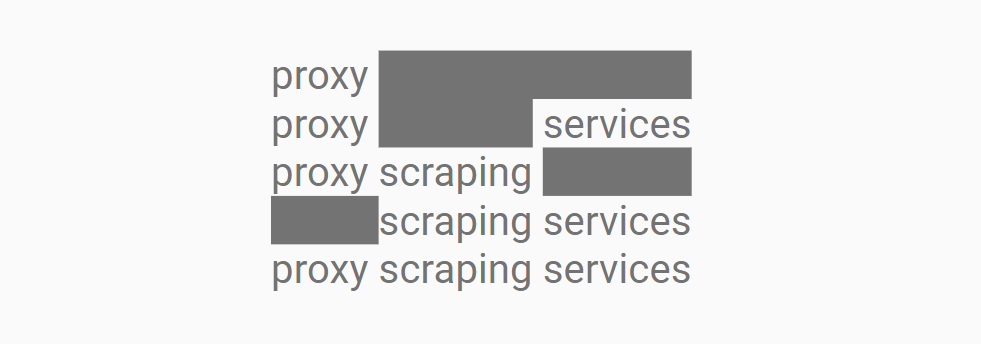 Image made by author, July 2024
Image made by author, July 2024
To do this, Google must annotate the query, and an annotator has a number of elements from a language identifier, stop-word remover, confidence values, and entity identifier.
This is because, as the above image demonstrates, the query [proxy scraping services] also contains a number of other queries and permutations. While these haven’t been explicitly searched for, the results for [proxy services], [scraping services], and [proxy scraping services] could have significant levels of overlap and burden the resources required to return three separate results as one.
This matters because AI and changing technologies have the potential to change how users perform searches. It is in part because we need to provide additional context to LLMs to satisfy our needs.
As we need to be explicit in what we’re trying to achieve, our language naturally becomes more conversational and expansive, as covered in Vincent Terrasi’s ChatGPT prompt guide.
If this trend becomes mainstream, how Google and search engines process the change in query type could also change current SERP structures.
Machine Learning & Intent Classification
The other side to this coin is how websites producing different (and more) content can influence and change search behavior.
How platforms market new tools and features will also influence these changes. Google’s big, celebrity-backed campaigns for Circle to Search are a good example of this.
As machine learning becomes more effective over time – and this, coupled with other Google’s algorithms, can change search results pages.
This may also lead Google to experiment with SCRBs and other SERP features in different verticals, such as financial product comparisons, real estate, or further strides into automotive.
More resources:
Creating Content That Satisfies Search Intent & Meets Customer Needs Keyword Research: An In-Depth Beginner’s Guide How Search Engines WorkFeatured Image: amperespy44/Shutterstock
Data-Driven Content Strategy: Boost Google Rankings With Real Audience Insights
Learn how to boost Google search rankings by using first-party data, zero-party data, and automated audience insights in your content strategy.
 CallRail
120 Reads
CallRail
120 Reads

The key to creating successful, high-ranking content is understanding your audience and knowing what resonates with them.
Sure, that may seem obvious – but it certainly isn’t simple, especially in today’s rapidly evolving search landscape.
Google’s frequent algorithm updates and back-and-forth statements about privacy put marketers are under immense pressure to adapt their strategies
Not to mention Google’s March 2024 core update, which aims to reduce AI-generated spam and unhelpful content in search results by 40%, thus impacting visibility for many sites.
So what does it take to stay ahead in search engine rankings amidst these changes?
Well, Google is making sure to put users first – and so should you.
But how do you create high-quality, relevant content that truly serves the user’s intent, without relying heavily on third-party data?
Luckily, there are other methods of audience data collection you can take advantage of, plus Google-friendly ways to implement AI into your strategy – we’ll cover them here.
Building Your Content Marketing Strategy Around First- & Zero-Party Data
Google’s latest updates mean that third-party content produced primarily for ranking purposes and without close oversight of a website owner will now be considered spam.
So if you don’t want to join the hundreds of websites that have been deindexed by Google recently, it’s crucial that you learn how to leverage first- and zero-party data to create your content.
But first, it’s important to understand the different types of data. Here’s a quick overview:
Zero-party data: Information customers share with companies. First-party data: Information companies collect about their customers. Second-party data: Customer information companies sell to each other. Third-party data: Data collected by organizations that do not directly interact with customers or business data consumers.Switching to a marketing strategy built around first- and zero-party data means changing the way you collect, analyze, and derive insights from data.
But if you’re like most companies, you’re probably already engaging with your customers in ways that generate lots of first- and zero-party data – you just may not be capitalizing on it yet.
Let’s explore three common ways you can start using real audience insights to improve your content, boost your rankings, and drive sustainable growth.
1. Phone Call Data Tracking
So you’re trying to get your content search engine ready, but there are some gaps in your data collection strategy.
With Google prioritizing helpful content in search results, the more insights you have into what your customers are looking for, the better.
As a small business, if you’re not yet tracking your phone call data, you’re leaving a lot of valuable information on the table that could transform your strategy.
It’s one thing to generate leads, but being able to properly attribute those leads to a specific aspect of your campaign is crucial to understanding audience behavior.
It’s like the classic, “how’d you find out about our business?” prompt – except you won’t have to ask. You’ll already know.
How Call Tracking Works
Most callers come across your business several times before actually picking up the phone.
Call Tracking helps you understand exactly what makes your phones ring and illuminates every touchpoint so you get a full picture of your marketing funnel.
With this advanced software, you can easily pinpoint which ads or search terms lead your customers to call – which provides valuable insight into what your customers are really interested in.
This data allows you to optimize spending for the campaigns or keywords that are most effective.
Now, what about the content of the actual calls? Well, you can use that, too.
Let dive into how you can use call analysis to further inform your strategy.
How To Analyze Your Call Data
The insights you collect from customer phone interactions can have a game-changing impact on your business.
But you want to make sure the effort required to dig into those calls is worth it for your team.
This is where AI and machine learning technology can be utilized effectively to streamline your process and save time.
For example, Conversation Intelligence is an AI-powered tool by CallRail that constantly records, transcribes, and analyzes each inbound and outbound call.
With transcriptions that have near-human level accuracy, Conversation Intelligence goes a step further by spotting keywords, tagging calls automatically, and qualifying leads with powerful automation rules.
Plus, with multi-conversation insights, you can easily transform countless conversations into actionable insights at scale.
Not only does this analysis unlock deeper insights to help you catch customer trends and spot long-term shifts, but it also tells you what you should focus on in your content.
2. Website Form Submissions
Another effective way to gather essential audience insights is through website form tracking.
Online forms allow you to collect valuable data directly from users, such as their contact information, preferences, and interests.
When this data is paired with deeper analytics, you can gain a clear understanding of what drives the most qualified leads for your business.
With Form Tracking, you can find out exactly which ad or keyword made someone click “submit” on your form.
Launched last year by CallRail, this tool allows you to build custom forms or integrate existing ones, pairing the data with inbound call conversions for a holistic view of your marketing efforts.
Combining Call Tracking And Form Tracking
Leads often connect with businesses through multiple channels, so focusing on just one source isn’t really enough.
By using Call Tracking and Form Tracking together, you get a comprehensive overview of your leads’ entire customer journey.
Both of these tools essentially work by installing a single line of JavaScript code on your site, which captures and relays information about each of your leads back to CallRail.
You can easily evaluate the various campaigns that you’re running, like paid ads, social media posts, email nurture campaigns, etc. – all of which could be opportunities to incorporate tracking numbers and links to your forms.
Using both a tracking number and a form tracking link gives your leads the option to choose how they prefer to contact your business.
And as they reach out, you’ll be able to measure which campaigns and which conversion type – calls or forms – is getting the best results.
3. Customer Feedback & Surveys
If you really want a deep dive into the minds of your customers, surveys are an incredibly effective way to get feedback directly from the source.
Surveys allow you to ask your users targeted questions and receive precise answers about their preferences, pain points, and expectations.
You can then leverage this comprehensive data to guide your marketing strategy and fill any content gaps you may have.
Discover the type of content your customers prefer, the topics they are most interested in, and how they like to consume information.
Once they point out areas where they feel your content is lacking or what they would like to see more of, you can then fill the gaps in your strategy to give them what they want.
Integrating Customer Feedback Into Your Content
Understanding your audience can help you tailor your content to better meet their needs and preferences.
Here are some tips for how you can effectively integrate customer feedback into your content creation process:
Create a Feedback Loop: Ask your audience to rate the usefulness, quality, and relevance of your content to gain a clear picture of where you can improve. Then establish a system where their feedback continuously informs your content. Regularly conduct surveys and update your strategy based on the latest insights. Prioritize High-Impact Content: Identify the topics and formats that resonate most with your audience and prioritize them in your content calendar. For example, if customers indicate a preference for video tutorials over written guides, focus more on creating video content. This ensures that you’re always aligned with what your audience finds most valuable. Test and Iterate: After publishing content based on customer feedback, monitor its performance to see if it meets the intended goals. Use analytics to track engagement, shares, and other metrics. Be prepared to refine your content based on ongoing feedback and performance data. Communicate Changes: Let your audience know that their feedback has been heard and implemented. This not only builds trust but also encourages more customers to participate in future surveys.Unlock Higher Search Rankings With Better Data Solutions
Google is constantly changing its algorithms to produce higher quality search results for users, which presents numerous challenges for marketers and website owners.
Between the upcoming phase-out of third-party cookies and the recent core update, the search engine is cracking down heavily on content it deems as unhelpful.
That’s why it’s time to take a user-first approach to your content strategy.
By leveraging first- and zero-party data through methods like call tracking, form submissions, and customer surveys, you can create high-quality, relevant content that meets your audience’s needs and boosts your Google rankings.
How To Create High-Quality Content
Master the art of creating high-quality content that meets user expectations and keeps them engaged and satisfied.
 SEJ Editorial
64K Reads
SEJ Editorial
64K Reads

SEO success depends on providing high-quality content to your audiences. The big question is: What exactly does “high quality” mean?
Content has many meanings. In digital marketing, it simply means the information a website displays to users.
But don’t forget: In a different context with a different emphasis on the word (content as opposed to content), content is a synonym for happy and satisfied. The meaning is different, but the letters are the same.
If you want to understand content quality online, keep these two different definitions in mind.
Every webpage has content. “High-quality” content depends on contexts like:
What the needs of your audience are. What users expect to find. How the content is presented and how easy it is to pull critical information out of it quickly. How appropriate the medium of the content is for users’ needs.What Makes Content High Quality?
This is a complex question that we hope to answer in full during this article. But let’s start with a simple statement:
High-quality content is whatever the user needs at the time they’re looking for it.
This might not be helpful in a specific sense but note this somewhere because it’s a guiding light that has far-reaching implications for your website and audience strategy.
We use this definition because the quality of your content isn’t static. Google and other search engines know this and frequently update search engine results pages (SERPs) and algorithms to adjust for changing user priorities.
You need to bake this idea into your understanding of content and audiences. You can have the most beautifully written, best-formatted content, but if your target audience doesn’t need that information in that format, it’s not “high-quality” for SEO.
If you provide a story when the user is looking for a two-sentence answer, then you’re not serving their interests.
This is especially pertinent with the introduction of generative AI features into search platforms. This is a continuation of a “zero click” phenomenon for certain types of searches and why Google doesn’t send a user to a website for these searches.
Defining & Meeting Audience Needs
SEO professionals have many different ways of conceptualizing these ideas. One of the most common is “the funnel,” which categorizes content into broad categories based on its position in a marketing journey.
The funnel is usually categorized something like this:
Top of the funnel: Informational intent and awareness-building content. Middle of the funnel: Consideration intent and product/service-focused content. Bottom of the funnel: Purchase intent and conversion content.While it’s helpful to categorize types of content by their purpose in your marketing strategy, this can be an overly limiting view of user intent and encourages linear thinking when you conceptualize user journeys.
As Google gets more specific about intent, such broad categorization becomes less helpful in determining whether content meets users’ needs.
Build a list of verbs that describe the specific needs of your audience while they’re searching. Ideally, you should base this on audience research and data you have about them and their online activity.
Learn who they follow, what questions they ask, when a solution seems to satisfy them, what content they engage with, etc.
Then, create verb categories to apply to search terms during your keyword research. For example:
Purchase. Compare. Discover. Learn. Achieve. Check.User Intends To Purchase
If the user is looking for something to buy, then high quality probably looks like a clean landing or product page that’s easy to navigate. Be sure to include plenty of detail so search engines can match your page to specific parameters the user might enter or have in their search history.
Product photos and videos, reviews and testimonials, and Schema markup can all help these pages serve a better experience and convert. Pay particular attention to technical performance and speed.
Remember that you’re highly likely to go up against ads on the SERPs for these queries, and driving traffic to landing pages can be difficult.
User Intends To Compare
This could take a couple of different forms. Users might come to you for reviews and comparisons on other things or to compare your benefits to those of another company.
For this content to be successful, you need to be dialed into what problems a user is trying to solve, what pain points they have, and how specific differences impact their outcomes.
This is the old “features vs. benefits” marketing argument, but the answer is “both.” Users could want to see all the features listed, but don’t forget to contextualize how those features solve specific problems.
User Intends To Discover
This intent could describe a user looking for industry news, data to support their research, or new influencers to follow.
Prioritize the experience they’re seeking and ensure that the discovery happens quickly.
This could look like adding text summaries or videos to the top of posts, tables of contents to assist with navigation, or page design elements that highlight the most critical information.
User Intends To Learn
If a user intends to learn about a topic, a long, well-organized post, video, or series of either may serve them best. This content should be in-depth, well-organized, and written by genuine topic experts. You may need to demonstrate the author’s qualifications to build trust with readers.
You must consider the existing knowledge level of your target audience. Advanced content will not satisfy the needs of inexperienced users, while basic content will bore advanced users.
Don’t try to satisfy both audiences in a single experience. It’s tempting to include basic questions in this type of content to target more SEO keywords, but think about whether you’re trading keywords for user experience.
For example, if you write a post about “how to use a straight razor” and your subheadings look like the ones below, you’re probably not serving the correct intent.
What is a straight razor? Are straight razors dangerous? Should I use a straight razor?The chances are high that someone landing on your page “how to use a straight razor” doesn’t need answers to these basic questions. In other words, you’re wasting their time.
User Intends To Achieve
A slightly different intent from learning. In this instance, a user has a specific goal for an action they want to perform. Like learning content, it should be written by subject matter experts.
If the person creating this content doesn’t have sufficient first-hand experience, they won’t effectively guide users and predict their real-world needs. This results in unsatisfying content and a failure point of many SEO content strategies.
In SEJ’s SEO Trends 2024 ebook, Mordy Oberstein, Head of SEO Brand at Wix, said:
“One trend I would get ahead of that aligns with Google’s focus on expertise and experience is what I’m coining “situational content.” Situational content attempts to predict the various outcomes of any advice or the like offered within the content to present the next logical steps. If, for example, a piece of content provides advice about how to get a baby to sleep through the night, it would then offer the next steps if that advice didn’t work.
This is “situational” – if X doesn’t work, you might want to try Y. Situational content creates a compelling form of content I see more frequently. It does a few things for the reader:
It addresses them and their needs directly. It’s more conversational than standard content (an emerging contenttrend itself). To predict various outcomes and situations, you have to actually know what
you’re talking about.
That latter point directly addresses E-E-A-T. You can only predict and address secondary situations with expertise and experience. Most of all, situational content indicates to the user that a real person, not a large language model (LLM), wrote it.”
The difference between “learn” and “achieve” intents can be difficult to see. Sometimes, you might need to satisfy both. Pay careful attention to these types of content.
User Intends To Check
Misunderstanding when a user just wants to “check” something can cause you to waste resources on content doomed not to perform, and another failure point of SEO strategies. If what a user needs can be solved in a few sentences, you’re in zero-click territory.
For example, ‘How to tie a bowtie’.
That is, Google will serve users an answer on the SERP, and they may not click a link at all. You may want to target these types of queries as part of longform content for other search intents using good content organization and Schema markup.
That way, you can give your authoritative and in-depth content opportunities to show up in rich results on SERPs, and users might click through if they see more information available or have follow-up questions.
You should consider these intents part of your SEO strategy, but think of them as awareness and branding tactics. AI features such as AI Overviews in Google seek to surface quick answers to queries. It will be much harder to acquire clicks on SERPs where features like this are activated.
If you struggle to understand why well-written content is losing traffic, you should assess whether you wrote hundreds of words to answer a query that only needed 30.
More intents exist, and to complicate matters further, they are not exclusive to each other in a single piece of content. Comparison and discovery intents, for example, often combine in listicles, product comparisons, and titles like “X alternatives to X.”
More reading about user intent:
How People Search: Understanding User Intent Creating Content That Satisfies Search Intent & Meets Customer Needs Understanding Buyer Intent Keywords Google Patent: Rewriting Queries Based on Context to Meet IntentContinue reading this article 👇
Content Quality Signifiers
While there’s no quantifiable answer to what good content means, there are many ways to evaluate it to ensure it contains key signs of quality.
Google’s content guidelines provide some questions you can ask yourself to objectively assess your content’s quality.
The SEO content mantra is E-E-A-T: Experience, Expertise, Authoritativeness, and Trustworthiness.
Google uses many signals to approximate these concepts and apply these signals to ranking algorithms. To be clear, E-E-A-T are not ranking factors themselves. But they are the concepts that ranking systems attempt to emulate via other signals.
These concepts apply to individual pages and to websites as a whole.
Experience: Are the people creating content directly knowledgeable about the subject matter, and do you demonstrate credible experience?
Expertise: Does your content demonstrate genuine expertise through depth, accuracy, and relevance?
Authoritativeness: Is your website an authoritative source about the topic?
Trust: Is your website trustworthy, considering the information or purposes at hand?
In its content guidelines, Google says this about E-E-A-T:
“Of these aspects, trust is most important. The others contribute to trust, but content doesn’t necessarily have to demonstrate all of them. For example, some content might be helpful based on the experience it demonstrates, while other content might be helpful because of the expertise it shares.”
Understanding these concepts is critical for building a content strategy because publishing content with poor E-E-A-T signals could impact your website as a whole. Google’s language downplays this potential impact, but it’s critical to know that it’s possible. It’s tempting to assume that because a website has high “authority” in a general sense or in one particular area, anything it publishes is considered authoritative. This may not be true.
If you chase traffic by creating content outside your core areas of authority and expertise, that content may perform poorly and drag the rest of your site down.
More reading about E-E-A-T:
Google E-E-A-T: What Is It & How To Demonstrate It For SEO Is E-E-A-T A Ranking Factor? Google’s E-E-A-T & The Myth Of The Perfect Ranking Signal E-E-A-T’s Google Ranking Influence DecodedContinue reading this article 👇
Creating Effective SEO Content
This article focuses on written content, but don’t neglect multimedia in your content strategy.
The thought process behind content should go a little bit like this:
Audience > Query (Keywords) > Intent > Brief / Outline > Create
You can also express it as a series of questions:
Audience: Who is our audience? Query: What are they searching for? Intent: Why? Brief: How can we best assist them? Create: What does exceptional user experience look like?Keyword Research For Content
Keyword research is a massive topic on its own, so here are some key pieces of advice and a few additional resources:
Look at the SERPs for the keywords you target to understand what Google prioritizes, what your competitors are doing, what success looks like, and whether there are gaps you can fill. Cluster related keywords together and develop a content strategy that covers multiple branching areas of a topic deeply. High search volume often means high competition. Allocate your resources carefully between acquiring lower competition positions and fighting for a slice of competitive traffic. Building a robust catalog of content focused on long-tail keywords can help you acquire the authority to compete in more competitive SERPs for related topics.More reading about keyword research:
Keyword Research: An In-Depth Beginner’s Guide How to Do Keyword Research for SEO: The Ultimate Guide Keyword Mapping: A Beginner’s GuideContinue reading this article 👇
Briefing SEO Content
Once you have performed your research and identified the intents you must target, it’s time to plan the content.
SEO professionals may not have the required knowledge to create content that demonstrates experience and expertise – unless they’re writing about SEO.
They’re SEO specialists, so if your website is about finance or razor blades, someone else will need to provide the knowledge.
Briefing is critical because it allows the SEO team to communicate all that hard work and research to the person or team creating the content. A successful brief should inform the content creators:
The target keyword strategy, with suggestions or a template for the title and subheadings. The purpose of the content for the user: What the user should learn or be able to accomplish. The purpose of the content for the business: Where it falls into the marketing strategy and relevant KPIs. Details such as length, style guide or voice notes, and key pieces of information to be included.Creating SEO Content
Your research should guide the format of your writing.
Remember, intent impacts the usability of different types of content. Prioritize the information most likely to solve the user’s intent.
You can do this by providing summaries, tables of contents, videos, pictures, skip links, and, most importantly, headings.
Use The Title & Headings To Target Keywords & Organize Information
The title of a page is your primary keyword opportunity. It’s also the first thing users will see on a SERP, which impacts CTR. Match the title to your target query and think about effectively describing the content to entice a click. But don’t misrepresent your page for clicks.
Your primary responsibility in SEO content is to set expectations and then deliver on them. Don’t set if you can’t deliver.
HTML heading formats help users navigate the page by breaking up blocks of text and indicating where certain topics are covered. They’re critical to your on-page SEO, so use your keywords.
Expectations are as true for headings as for titles. Headings should be descriptive and useful. Prioritize setting an expectation for what the user will find on that part of the page and then delivering on that expectation.
More reading about headings:
How To Use Header Tags: SEO Best Practices 14 Most Important Meta And HTML Tags You Need To Know For SEO Google Explains How to Use Headings for SEO 16 Free Title Generator Tools For Writing Better Headlines How To Write A Headline: 10 Tips For Getting It RightContinue reading this article 👇
Get To The Point
Whether content should be long or short is subjective to its purpose. All SEO content should be as short as possible while achieving its goals. “As short as possible” could mean 4,000 words.
If you need 4,000 words to achieve your goal, then use them. But don’t add any more than you need.
This is a call to avoid rambling, especially in introductions. Do you really need to cite the projected growth of an industry just to prove it’s worth talking about?
Not unless you’re writing a news story about that growth. Cut that sentence and the link to Statista from your introduction. (No shade, Statista, you rock.)
Features like skip links can also help with this. Give users the option to skim and skip directly to what they need.
Use Internal Links To Connect Your Pages Together & Provide Further Reading
Internal links are the bedrock of SEO content strategies. They are how you organize related pages and guide users around your website. They also spread the SEO value of your pages to the pages they’re connected to.
In the keyword research section, we suggested that you create clusters of keywords and topics to write about – this is why. You build authority by covering a topic in-depth and creating multiple pages exploring it and all its subtopics.
You should link between pages related to one another at contextually important points in the content. You can use this tactic to direct the SEO power of multiple pages to one important page for your strategy or your business.
Contextually relevant links that properly set expectations for what the user will find also contribute to a good site experience.
More reading about internal linking:
Internal Linking is Super Critical For SEO Sentence-Level Semantic Internal Links For SEO Internal Link Structure Best Practices to Boost Your SEO How Should We Internally Link Hub & Spoke Content For SEO?Continue reading this article 👇
Use Personal Experiences And Unique Expertise To Stand Out
AI presents numerous challenges for SEOs. Anyone can quickly create content at scale using generative AI tools.
The tools can replicate competitors, synthesize content together from myriad sources, and enable breakneck publishing paces. This poses two core problems:
How do you stand out with so much AI content out there? How do you build trust in audiences looking for legitimate experts?For now, the best answer is to lean into the E-E-A-T principles that Google prioritizes.
Tell human stories with your content that demonstrate your experience and expertise. Use Oberstein’s “situational content” principle, mentioned earlier in this article, to connect with your audience’s experiences and needs. Ensure that content is created by verifiable experts, especially if that content involves topics that can impact the audience’s well-being (YMYL.)SEO Content Is Both A Strategy & An Individual Interaction
It’s easy to focus on what you need from users: what keyword you want to rank for, what you want users to click, and what actions you want them to take.
But all of that falls apart if you don’t honor the individual interaction between your website and a user who needs something.
Audience-first content is SEO content. Content is a core function of SEO because it’s the basis of how humans and algorithms understand your website.
More resources:
AI Agnostic Optimization: Content For Topical Authority And Citations Trending Content Output Compared In ChatGPT, Gemini, And Claude Content Marketing: The Ultimate Beginner’s Guide to What WorksFeatured Image: Art_Photo/Shutterstock
Creating Content That Satisfies Search Intent & Meets Customer Needs
Want to create a content strategy aligned with search intent at every stage of the funnel? Here's what you need to know.
 Zack Kadish
13K Reads
Zack Kadish
13K Reads

When thinking about optimizing content, your top priority should be search intent.
Think about how many times you have typed something into Google that was practically gibberish, and Google understood exactly what you meant.
This is something we may take for granted, but it’s the exact reason why search intent is so important.
Monthly search volume is nice to have, but since it’s impossible to create demand, we need to align our high quality content and our product landing pages with the customer’s intent.
Google has never really cared about us optimizing our content.
It cares about serving the user the most relevant and unique content to help them find what they are looking for.
Google updates its algorithm so often because it wants to make sure that it is meeting the hearts, minds, and souls of its users, and matching their queries with relevant results.
In this article, we will review why search intent is the most important thing to consider when optimizing content, and how to create a content strategy based on research around search intent.
What Is Search Intent?
Search intent – also known as customer intent and user intent – is the primary reason behind users going to a search engine and typing in a query.
When someone visits a search engine, they have a specific goal in mind that they are trying to accomplish with their search.
Think about all the times you have used a search engine to conduct research around a product, or to get a question answered.
And with the growth of mobile search, we now have a search engine in our pockets at all times.
That’s why, as marketers and SEO professionals, we need to understand what part of the buyer’s journey our customers are at when they type in a specific phrase – and on which piece of content or landing page we should target this phrase.
Search intent is truly the backbone of a well-optimized landing page and should be our primary focus when creating content on our site.
But, we need to keep in mind the different stages of a customer’s search journey.
What Are The Different Types Of Search Intent?
There have been many times when I’ve searched Google before even knowing what I’m looking for.
Other times, I’ve used it to spellcheck, or to remind me of a particular movie’s name.
For the most part, we can group search intent into three main categories.
See how you can plan and create content to meet the following three types of search intent.
1. Informational
These are early-stage search queries where the customer is still trying to learn more about the topic.
When a user is in the early stages of searching, our goal is to make sure that the user learns more about the product or service.
Studies show that if a user learns something from a website and the site establishes itself as an authoritative source on the topic, that user will end up coming back to the website – and converting later on, when they are ready.
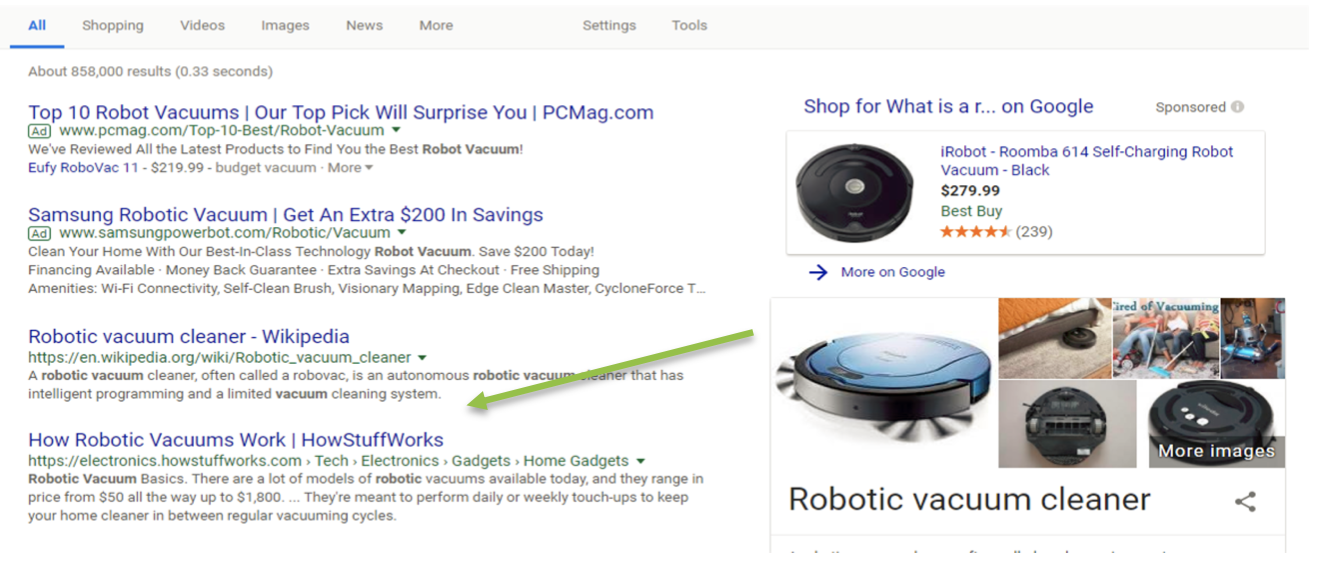 Image from Google, June 2022
Image from Google, June 2022
2. Comparative (Also Known As Navigational)
This is middle-stage content where the customer is looking to compare your product or service with another to help them decide what to do.
Users who are in the middle or comparative stage are trying to see if they really need the product or service they were researching, or if there are even better options than the one they had previously found.
Think about all the times you’ve compared different restaurants to each other, or two similar products.
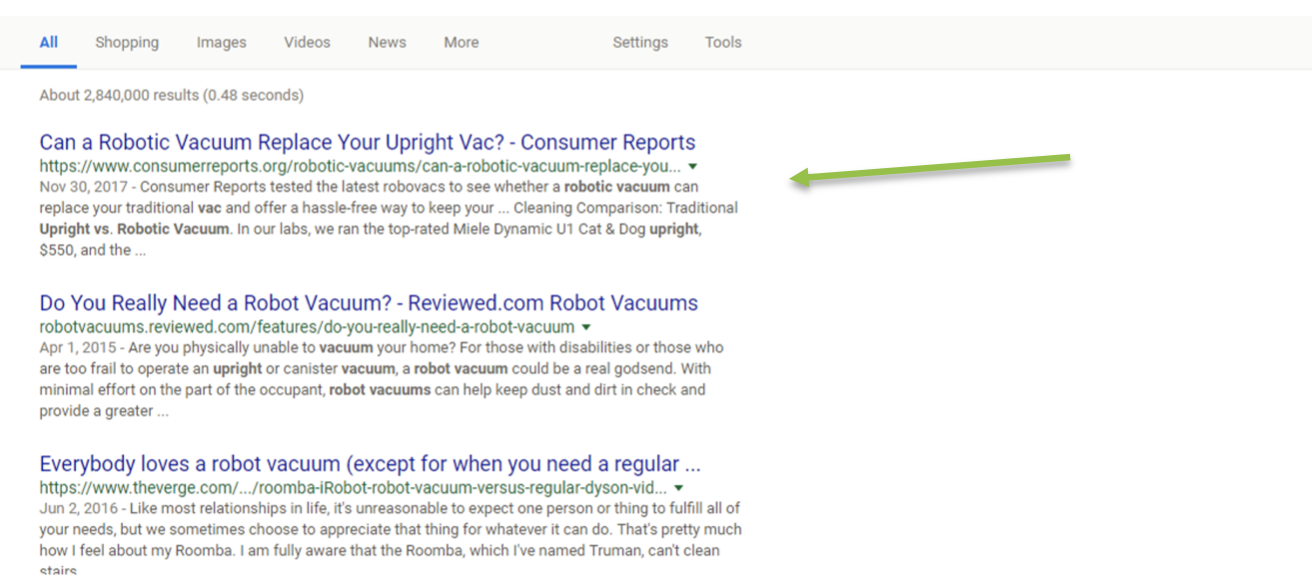 Image from Google, June 2022
Image from Google, June 2022
3. Transactional
This is late-stage content where the customer is ready to convert.
The reason we’ve created all of the other content is to make sure we are supporting our users and helping them along the way, so they can convert.
Our transactional or end-stage content is typically category or product pages where we want the user to land when they are ready to purchase.
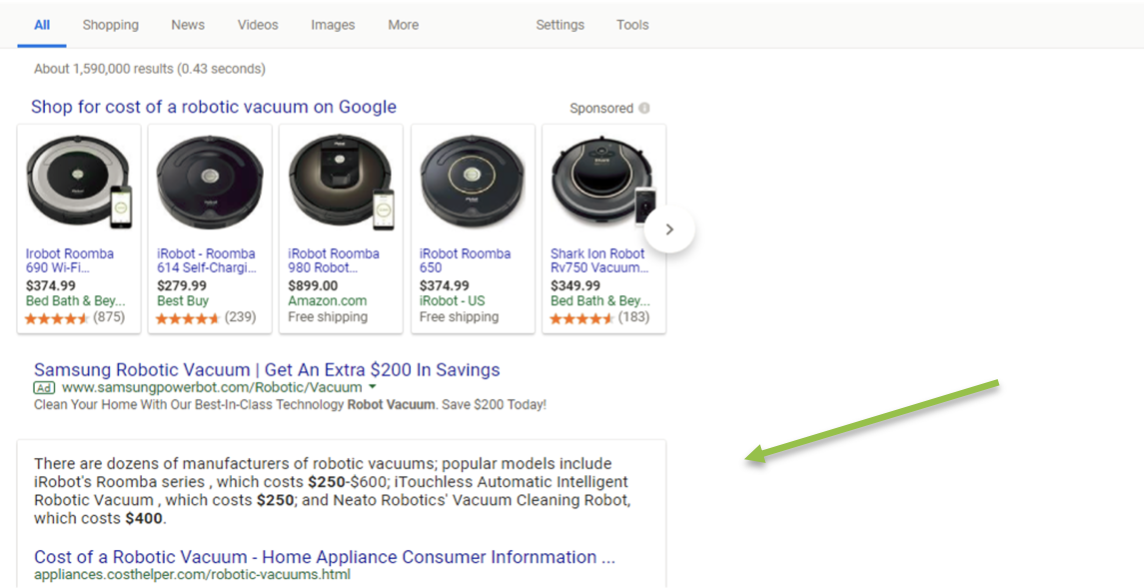 Image from Google, June 2022
Image from Google, June 2022
It’s important that when we are creating content, we make sure that the phrases we are targeting align with the intent of what the user is searching for.
By creating content and landing pages that match all parts of a user’s journey, we can ensure we are targeting the right keywords on the best page that Google wants to show.
We can also make sure that we are owning our own digital presence and increasing visibility and conversions.
While half of the battle is making sure our content is optimized properly, the other half is making sure Google even wants to show our content based on the phrase – which is why search intent is so important.
What Makes Search Intent So Important?
There are thousands of different factors to consider when doing keyword research, such as search volume, seasonality, branded vs. non-branded, localization, etc. But search intent, or user intent, is the most important one.
Understanding the searcher’s intent ensures that we are prioritizing relevancy in our content and in our keywords.
The more phrases a user is typing into Google or another search engine, the further they are in the buyer’s journey, and the more likely they are to convert.
Search intent is also extremely difficult to figure out.
But once you have an understanding of search intent, it makes optimizing content much easier – as you will know more about what type of content Google wants to show on Page 1.
The main thing we should consider is that we are not deciding what the search intent is – Google is.
If you go against what Google says, your content won’t show up in SERP.
There are also many instances where marketers or executives are blinded by search volume; rather than going after the lower volume phrases they have a better chance of winning, they pursue the higher volume phrases – and end up missing the mark.
How Can We Make Sure Our Content Aligns With The Search Intent?
When you’re struggling to grasp the concept of search intent, take a step back from your company and imagine you are a user.
Think about what you might search for in order to land on your blog article or product page.
Type that phrase into Google (preferably via Incognito or private browsing, so it’s not personalized towards your search history), and see what shows up.
A SERP (search engine result page) analysis is the best way to confirm what Google thinks the user may want to see.
Are there content aggregators? Are there transactional sites?
Is there a mixed search engine result page with both content and transactional content?
There are many times when even Google doesn’t know what the user is looking for, so it shows a mixed SERP with different types of content.
By finding this information live on the SERPs, we can see what Google is rewarding in the top positions, and what it believes is the intent of the user’s query.
SERP analysis is one of the best ways to use competitive data when creating content, because we want to know what phrases they are using and see if we can even compete for that same phrase based on intent.
How Can We Create A Content Strategy For Search Intent?
Content might be king, but the user has all the power.
We can create the best content in the world, but if the keywords we are targeting don’t match the intent of the user, it’s really all for nothing.
Bringing in unqualified traffic helps no one, and is a waste of our time and energy.
We need to make sure we are doing keyword and competitive research before creating our content.
By understanding who else is competing on the SERP, we now know if we have a chance of ranking on Page 1.
Competitive research also allows us to find semantically related keywords that we might want to use in the content. These are keywords that are not necessarily synonyms, but are closely related in nature.
Semantically related keywords give search engines a better understanding of what our content is about, and also enable users who are searching for similar things (but using different keywords) to find our content.
One of the best ways to create a content strategy with search intent in mind is the hub and spoke content marketing model.
This content marketing model allows us to target our transactional keywords on the hub pages and the more informational keywords on the spoke pages.
By doing this, we can make sure we have content that matches where our users might be, and the different stages of their journey.
Keyword research is the bread and butter of a content strategy, and it’s extremely important when understanding search intent.
The keywords with the most search volume might be attractive, but they can also be very vague and may not be the best words to focus on.
There are also many times when some keywords – singular or plural – have a different meaning.
For example: If you search for [TV] you could be looking up a television channel guide or the history of the television.
But, if you search for [TVs], you’re probably looking to purchase a television from somewhere and will see corresponding search results.
The point being: SEO professionals need to continuously look at what is already showing up on Google, and adopt the user’s or customer’s perspective when searching.
This visual helps us better understand the content strategy we might go after if we sell reading glasses.
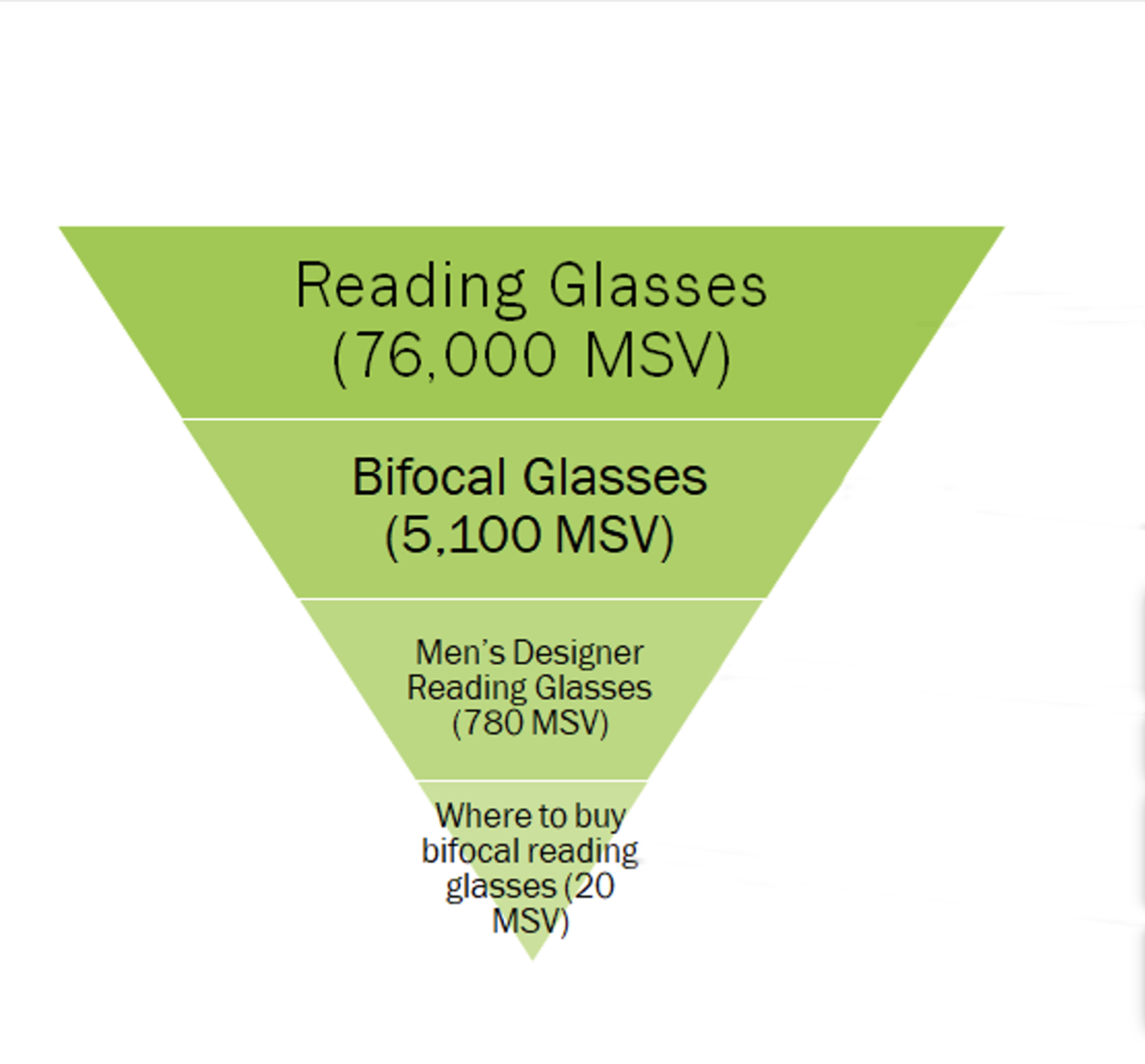 Image created by author, June 2022
Image created by author, June 2022
We should be targeting the higher volume keywords on our homepages or category pages.
The lower volume keywords could then be targeted on sub-categories, product pages, and perhaps a blog article.
By creating a visual like this, we can identify the total amount of keywords we are trying to go after, which can help us understand how much content or what type of content we need to create.
In Conclusion
Putting our customers first and identifying the search intent of their query is the best way to ensure our content matches our customer’s needs.
We’ve also only talked about half the story: the research side.
The exciting part comes when you’re able to utilize an enterprise SEO platform to monitor keyword rankings and report back to executives on the changes you made – and how they resulted in a significant increase in traffic or conversions.
By monitoring and reporting our wins frequently, we can get more buy-in to our SEO program and evangelize why SEO is important to our organization, making it easier to have a seat at the table for bigger decisions.
Search intent will always be the most important factor when it comes to keyword research and optimizing our content.
Google’s recent algorithm updates have been very focused on user experience, but it continues to put more emphasis on user intent and making its search engine more conversational in order to produce the most accurate search results for users.
So when in doubt, make sure that search intent and relevancy of keywords are your main focus areas when creating and updating content.
More resources:
How To Automate SEO Keyword Clustering By Search Intent With Python Intent-Based SEO & PPC: 5 Ways to Build Incremental Benefit How Search Engines WorkFeatured Image: maradon 333/Shutterstock
Mastering Content Mapping: A Strategic Approach To Boost SEO
Drive more traffic to your site and turn visitors into customers with content mapping. Keep reading to learn how to make one for your business.
![]() Adam Heitzman
10.0K Reads
Adam Heitzman
10.0K Reads

Successful SEO content should act as a guide – not just around your website, but for users on their specific journey to answers and solutions.
Visitors to your website arrive with different intentions and levels of awareness.
Some may be casually browsing your site for the first time, others might be actively researching your products or services, and others may be on the verge of making a purchase.
So, what should you do to ensure your website caters to these diverse goals and needs? And how should you use content to facilitate the journey from early-stage prospect to repeat customer?
The answer: content mapping.
In this post, we’ll cover the importance of content mapping for SEO and explain how to develop a content strategy that helps transform visitors into customers.
Let’s dive in.
What Is Content Mapping?
Content mapping is the process of aligning content with the specific needs of your target audience at various stages of the buyer’s journey.
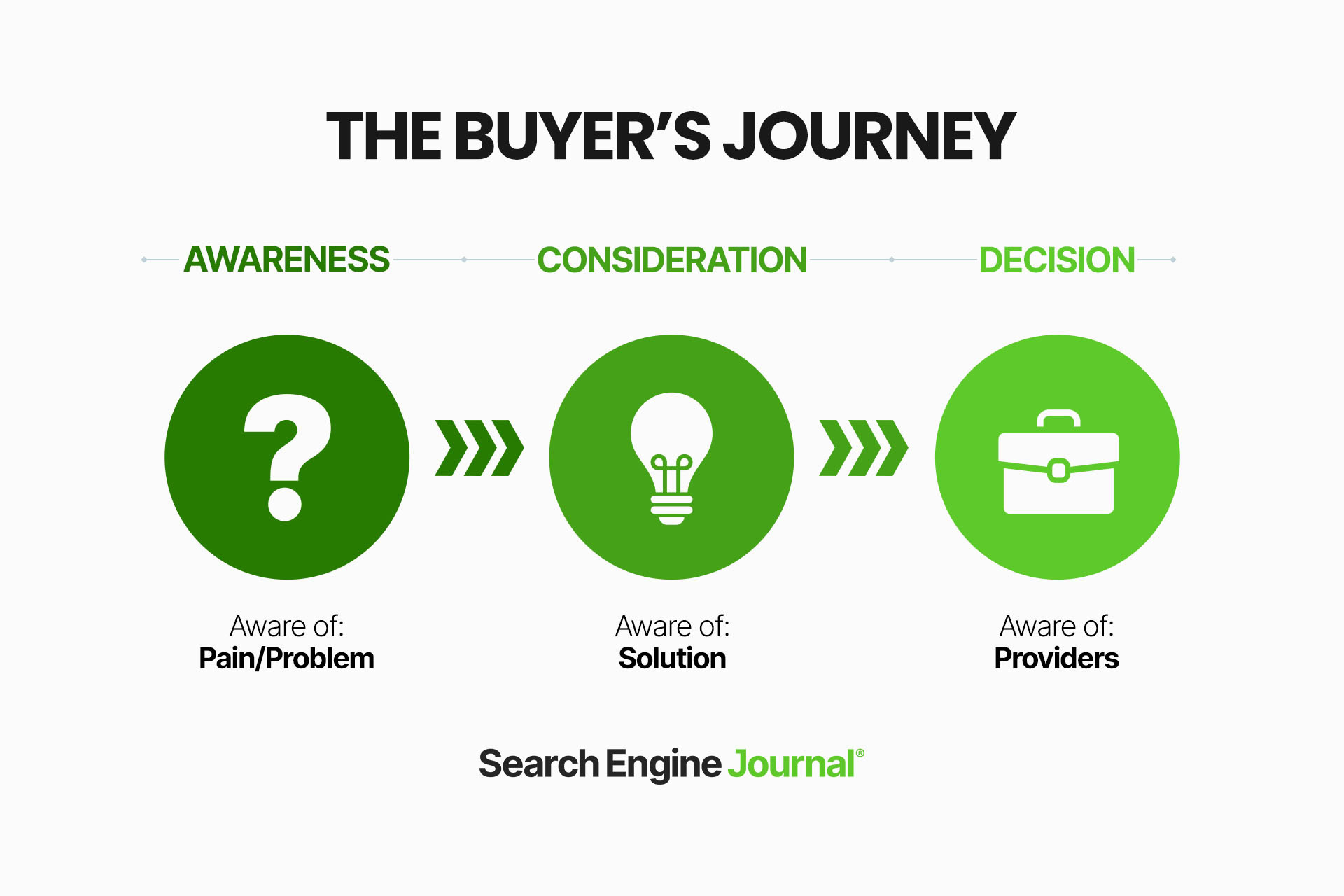
It involves defining your audience, understanding what content they need at different phases of the decision-making process, and delivering that content to guide them from initial awareness to a purchase decision (and beyond).
In other words, content planning is about organizing your site so that the right content reaches the right user at the right time.
Why Is Content Mapping Important For SEO?
Creating a content map can bolster your SEO efforts in multiple ways. Here are the key reasons content mapping matters for SEO.
Better Content Relevance And Targeting
Google aims to surface the most relevant results it can find for users’ search queries.
The more relevant the content, the more likely it is to rank higher in search results.
Content mapping helps increase your content’s relevance by aligning it with the search intentions of your target audience at different stages of the buying journey.
Increased User Engagement
Relevant content that directly addresses the goals and needs of visitors is also more engaging.
Better engagement means longer session durations, lower bounce rates, and more frequent interactions – all of which signal to Google that your site is a quality source of content worth ranking prominently in its search results.
Improved Keyword Optimization
Content mapping involves identifying the keywords your prospects use along the buyer’s journey.
Once you know which keywords people use at various stages of the customer lifecycle, you can incorporate those terms into the appropriate pages on your website.
Targeting a broad range of keywords lets you cater to a broader range of user intentions and boosts your organic visibility.
Structured Content Delivery
A well-planned content map helps create a clear and organized content architecture for your site.
A logical site structure improves user experience and makes it easier for search engines to crawl and index your pages correctly.
Moreover, strategic linking between thematically-related content can enhance your site’s authority for particular topics.
Support For Content Updates
A content map provides a complete overview of your site’s content, laying out the relationship between different pieces of content and their respective stages in the buyer’s journey.
With a map in hand, it’s easier to see which parts of your site are outdated or underperforming and to spot new opportunities to develop more content.
Remember, search engines favor fresh, up-to-date content, which can help maintain or improve your rankings over time.
How To Create An Effective Content Map In 6 Steps
Now, let’s break down the content mapping process.
1. Define Your Buyer Personas
The first step is to develop a clear understanding of your various customer segments.
The better you understand your ideal customers’ needs, goals, motivations, and objections, the easier it will be to create content that serves them.
The goal here is to create buyer personas (or customer avatars) that represent your target audience.
Start by gathering as much information as possible on your existing customers through surveys, interviews, customer service data, and website analytics.
Look for demographic data such as age, location, income level, and psychographic data, including personal interests, buying preferences, and lifestyle choices. Learn the challenges that lead them to seek products and services like yours.
Once you’ve collected this data, it’s time to build out your buyer personas. Each persona should be detailed and specific, like this:
Buyer Persona: “Digital Marketer Dan”
Demographics: Age 32, lives in San Francisco, single, masters in marketing. Professional role: Senior digital marketing manager at a tech startup. Goal: To increase brand awareness and lead generation through innovative digital strategies. Challenges: Struggles with limited budget and resources; needs tools that maximize ROI. Behavioral traits: Highly active on LinkedIn, relies on industry blogs and webinars for ongoing education. Decision factors: Prioritizes cost-effective software and tools with strong user support. Preferred content types: Enjoys in-depth guides, case studies, and free webinars.Here is a sample buyer persona we developed for my agency, HigherVisibility:
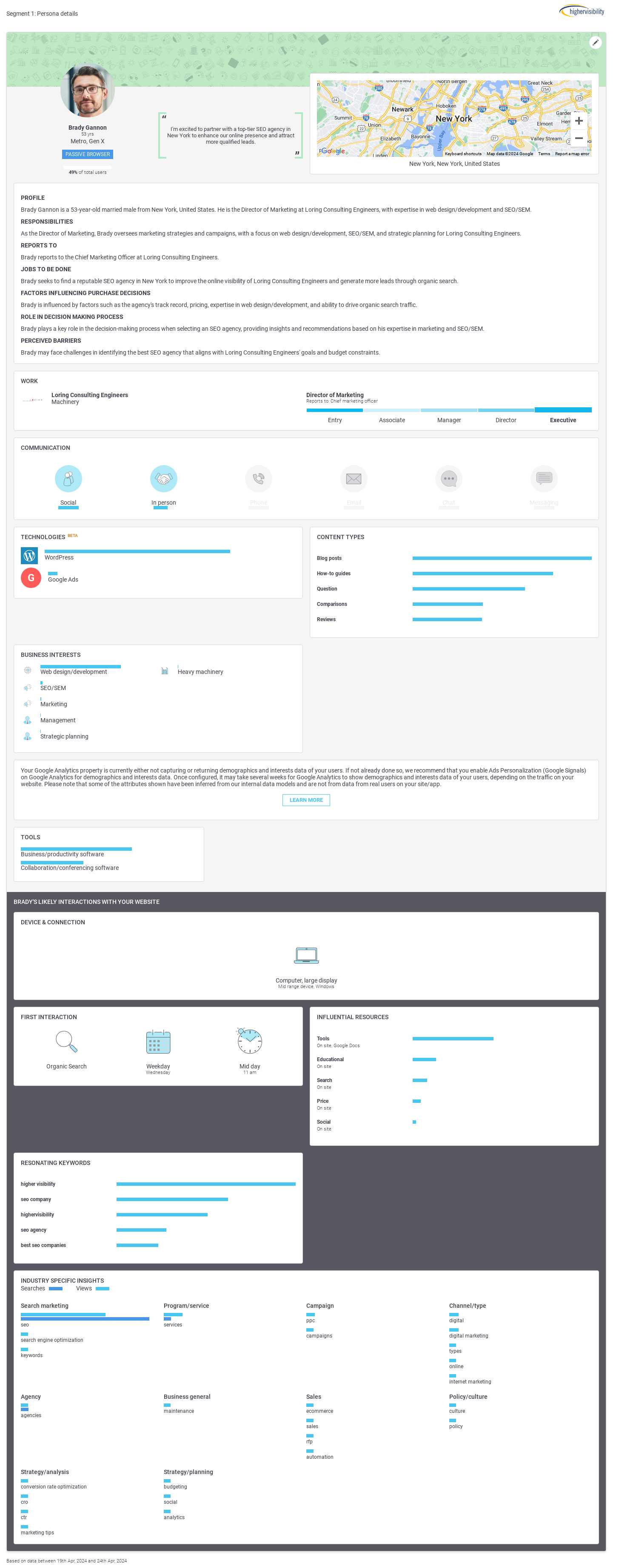 Screenshot from author, May 2024
Screenshot from author, May 2024
2. Map Out The Buyer’s Journey
The next step is to map out the customer journey for each of your personas. This will guide you in creating content that meets the needs of different personas at every stage of the decision-making process.
Typically, the customer journey is made up of three main phases:
Awareness: Here, the persona first becomes aware of a problem or need. For example, “Digital Marketer Dan” realizes he needs to improve his digital marketing ROI. He heads to Google for ideas and clicks through to one of your blog’s educational posts discussing various digital marketing strategies. Consideration: At this point, your persona will be evaluating different solutions to their more fundamental problem. For example, Dan has realized that his team needs a new digital marketing platform to optimize campaigns more effectively. Now, he’s researching the features and benefits of different tools to see which solution can best meet his needs. To get a better sense of what your company offers, Dan reads through a few of your comparison guides and watches your product demonstration videos. Decision: In this final phase, your persona has considered their options and is primed to make a buying decision. For example, Dan is now almost ready to buy. To alleviate any last-minute concerns, he reads through positive feedback from other customers on your testimonials page and then finally reaches for his bank card.Read more: How To Create A Customer Journey Map
3. Map Existing Content To Different Stages Of The Buyer’s Journey
Now, it’s time to categorize your existing content according to where it fits into the customer journey.
A common approach here is to separate content into three buckets:
Top of the funnel (TOFU): This content caters to visitors in the awareness stage. The goal here isn’t to make a sales pitch. Instead, it’s about providing useful information, establishing your brand as a trustworthy source of insights, and raising awareness that your solution exists. TOFU content includes blog posts, infographics, and educational videos about topics within the remit of your brand. Middle of the funnel (MOFU): This content caters to those in the consideration stage. It delves deeper into the benefits and features of your solution, showing visitors how it can help address their problems. Examples include webinars, case studies, and product overviews. Bottom of the funnel (BOFU): This content is designed to help purchase-ready visitors commit to a final decision. Since users are now familiar with what you can offer them, the goal is to address any lingering objections or questions standing in the way of a sale. BOFU content includes special offers, free trials, shipping and refund policy pages, customer reviews, and testimonials.4. Optimize Existing Pages For The Right Keywords
After identifying where each page fits into the customer journey, you’ll need to ensure those pages are optimized for the appropriate keywords.
But before you get started, we recommend you first refresh and expand your current keyword list to make it as up-to-date and comprehensive as possible.
The aim is to build a complete picture of the type of queries people use when searching for TOFU, MOFU, and BOFU content related to your business. Be sure to include search intent and search volume data in your list.
Once your new keyword list is ready, make sure each page is optimized for a relevant primary keyword if it isn’t already.
Here are some best practices to keep in mind when optimizing your content for keywords:
Match pages with keyword intent. Only assign a keyword to a page that genuinely addresses the search intent underlying that term. If you don’t yet have a page for a given keyword, you can add it to your content calendar (see Step 6). Update meta tags. Adjust the title tags, meta descriptions, and header tags to include your target keyword and any close variants. This not only helps Google understand the page’s relevance but can also encourage more click-throughs from the search results. Add keywords to the content. Integrate your target keyword into your content, especially the introduction, conclusion, and headers. All keyword placements should appear natural to the reader. Also, avoid cramming your text with keywords – keyword stuffing is considered spam by search engines and can damage your SEO efforts. Avoid keyword cannibalization. When two or more pages from the same website target the same term, search engines have difficulty determining which page to rank. This can dilute the ranking potential of all the competing pages. So, try to make sure that no two pages target the same primary keyword.Read more: Keyword Research: An In-Depth Beginner’s Guide
5. Update Internal Links Strategically
Internal links are the routes your users take from one page to another. Not only are they essential for site navigation, but they also help distribute link equity (ranking power) from high-authority pages to lower-authority ones.
However, since your website’s ultimate goal is to generate conversions, each page should contain links that direct users to the next step along the buyer’s journey.
For example, suppose your business sells and installs smart home technology.
Your blog post about “Improving Home Security” (TOFU) might contain an in-text link to a related comparison guide about “The Best Smart Home Security Systems of 2024” (MOFU). Likewise, the comparison guide might contain a link directing readers to your testimonials page (BOFU).
6. Identify Content Gaps To Inform Your Editorial Calendar
The next step is to identify opportunities to create new content or add to existing content.
After expanding your keyword list in Step 4, you will most likely find several relevant keywords for which you don’t currently have content. These keywords can form the basis of your new content calendar.
When deciding which keywords to prioritize in your production schedule, keep the following in mind:
Marketing goals: What is your primary marketing goal? If it’s to generate more traffic and brand awareness, targeting TOFU keywords should be your priority. If the aim is to maximize sales conversion rates, targeting BOFU keywords might be a better option. Relevance to your audience: Prioritize keywords that reflect your core audience’s needs. Ask whether there are any topics or questions your buyer personas are likely to have that your content doesn’t currently address. Search volume and competition: High-volume keywords are typically harder to rank for. Consider creating content clusters to increase your site’s authority for specific topics. Content clusters involve a central “pillar” page providing an overview of the main topic, which links to multiple “cluster” pieces covering related sub-topics in more depth.Final Thoughts
Creating a content map is a powerful strategy for any business looking to increase their organic visibility and maximize their website’s ability to attract qualified visitors and convert them into customers.
By understanding and addressing the various needs of your audience throughout the buyer’s journey, you can position your brand as a valuable source of information and guide visitors from initial awareness to making a purchasing decision.
Building a content map requires careful planning and attention to detail. You should treat it as a living document that evolves with your audience’s needs and business goals.
Regularly reviewing and updating your content map will ensure it remains relevant and effective in guiding your content strategy.
More resources:
How To Create A Content Strategy Framework What Is A Conversion Funnel? Optimize Your Customer Journey B2B Lead Generation: Create Content That ConvertsFeatured Image: watchara panyajun/Shutterstock
Tangential SEO: Finding Keywords for Content No One Else Has
Content marketers or business owners can benefit from scraping ideas and creating unique content your competitors don't have. Here's a comprehensive guide to help you.
 Andy Chadwick
21K Reads
Andy Chadwick
21K Reads

In the rapidly evolving world of SEO, staying ahead of the curve is critical.
Traditional SEO focuses on optimizing for keywords and topics directly related to your business.
However, as markets become increasingly saturated, new strategies are needed to stand out and reach a broader audience. That’s where tangential SEO comes in.
Tangential SEO involves creating and optimizing content for topics that are tangentially related to your core business. This allows you to engage with audiences who may not be actively looking for your products or services but who could still find them relevant or useful.
It is a strategy designed to build brand visibility, establish authority, attract a wider audience, and ultimately drive more traffic to your site.
Whether you’re a content marketer seeking to diversify your strategy, a business owner aiming to extend your online reach, or a newcomer to the field eager to learn, this guide is for you.
Not only will I explain what tangential content is at a broader level, but I’ll also show you how we find alternative keywords using untraditional methods.
You’ll have a methodology for finding keywords none of your competitors have even thought about.
Excited?
Let’s begin.
What Is “Tangential Content”?
Quite simply, tangential content is content that is not directly related to your product or service offering.
For example, instead of only focusing on sportswear, Nike might generate content around topics like music playlists for different moods or workout routines, exploring various global music trends.
It could even discuss urban design and its impact on outdoor physical activities. These are topics not directly related to Nike’s products but themes that would likely resonate with its audience.
Let’s give some more examples for context:
Starbucks: Beyond coffee, Starbucks could create content discussing books and literature, considering that many people enjoy reading while sipping its coffee. The brand could start a book club, share reviews, and host author interviews. Apple: Apple might deviate from its technology-centered content to explore topics like interior design, highlighting aesthetic and minimalistic arrangements that complement its devices or discussing how different spaces foster productivity and creativity. IKEA: While primarily focused on furniture, IKEA could develop content around topics like urban gardening, offering tips for creating green spaces in small city apartments, or sharing recipes to create using limited kitchen tools.Why Create Tangential Content?
Creating tangential content can have numerous benefits, particularly when it comes to reaching a wider audience, building brand authority, and improving SEO performance.
As a food lover, I wanted to try and squeeze a food analogy in, so I’m going to do it here. Let’s consider the benefits of creating tangential content as a master chef in the culinary world.
Broader audience reach: Just like a versatile chef caters to various palates, tangential content allows your brand to cater to a wider audience – which is especially important for weirder or more abstract niches. Increased engagement: Changing up the menu keeps diners interested, just like a variety of content can keep your audience engaged. By showing that your brand can whip up more than just the standard fare, you’re demonstrating a deeper understanding of your audience’s diverse tastes. Building brand authority: When you create a variety of dishes, you prove your culinary skills beyond your signature dish. Similarly, creating content on a range of topics positions your brand as an authority in your field, enhancing your reputation and influence. Creating more emotional content and aligning with customer lifestyle: Tangential content is akin to designing a themed dining experience that aligns with your customer’s lifestyles and preferences. For instance, if you know your customers are environmentally conscious, you might focus on farm-to-table ingredients or share stories of local farmers. This not only provides content that resonates emotionally but also aligns your brand more closely with your customer’s values and lifestyles. Link building: Just as a unique fusion dish might get rave reviews and recommendations, tangential content often has a higher potential to be shared, earning you backlinks from various domains. These backlinks boost your site’s authority, much like word-of-mouth boosts a restaurant’s reputation. SEO performance: By offering a variety of dishes, you’re catering to more tastes and attracting more diners. Similarly, by covering a range of topics, you’re likely to rank for more keywords, attracting more organic traffic to your website.While the benefits of publishing tangential content are clear, don’t overlook the value in the research process itself.
The analogy continues like so: consider researching tangential content ideas similar to the time a chef spends experimenting in the kitchen and interacting with their customers.
It’s during this phase that the chef discovers which dishes their customers can’t get enough of, which ones they’re not too fond of, and what cuisine they’re yearning to try next.
In the same way, when you research diverse topics for your tangential content, you’re not only gathering material for your next post – you’re also gaining a broader understanding of your customers’ unmet needs or interests.
This insight is just as valuable, if not more so, as it can guide the development of new products, services, or post-purchase support articles.
So, even before you’ve served up your tangential content to your audience, the research phase itself can help you refine your ‘menu,’ making your brand more attuned to your customers’ tastes and more valuable in their eyes.
Hopefully, the hokey simile made sense, hasn’t made you hungry, and you’re sold on the concept of tangential content.
I’ll now show you how we generate tangential content ideas.
How To Generate Tangential Content Ideas?
To walk through the following process, I’m going to use an example as if I was doing this research for a fictional hair removal company.
Step 1: Establish Buyer Personas
Buyer personas are essentially fictional representations of your ideal customers, often based on real data and market research about your existing customers. They help us understand our customers (and potential customers) better and make it easier for us to “get into their minds.”
These personas can include information such as demographics, behavior patterns, motivations, goals, challenges, values, and fears.
Sometimes your marketing department will already have one of these, but if they don’t, you could ask our new friend, ChatGPT, to produce one.
Step 2: Create A Mind Map
A mind map typically starts with a central idea, placed in the middle of your page. From this central idea, you’ll draw lines that branch out into main topics.
It’s like a tree sprouting branches.
These main branches can further sprout smaller branches, each representing related subtopics or ideas.
In our scenario, we’ll plant the name of the buyer persona as the seed of our mind map. From there, we’ll let branches grow out, each representing key values, aspirations, preferences, and hobbies that we’ve identified for this persona.
Remember, this isn’t the stage for keyword research; there’s no need to think about keyword volume data. This is more about emptying out your mind and exploring potential questions this persona might have.
This process is about trying to see the world through their eyes.
If you find that you’re not the best match for this persona – for example, if the persona is a 28-year-old woman and you’re not a 28-year-old woman (as I am not) – then it could be beneficial to bring in someone who aligns more closely with the persona.
This way, you can ensure you’re covering all bases and not missing any important insights.
In any case, here’s one I started doing for a persona I called “Sarah Thompson.”
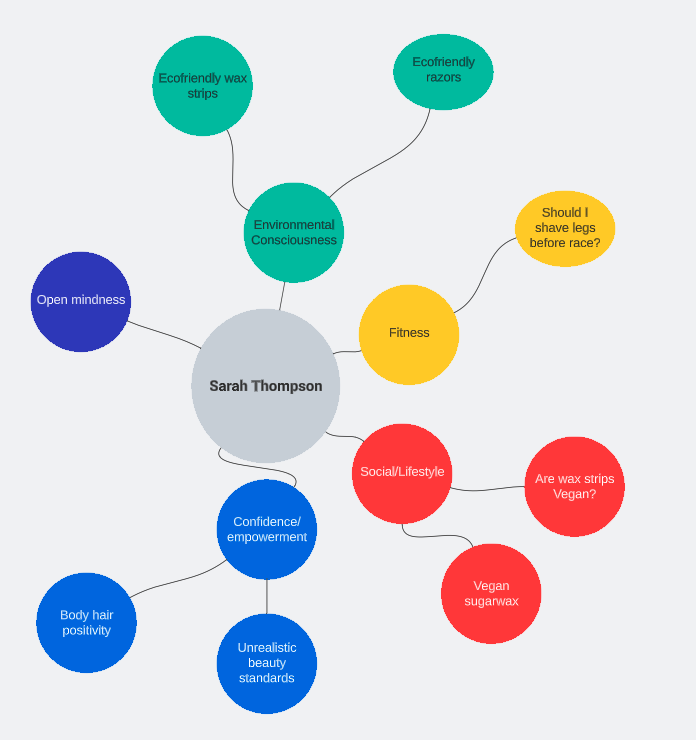
Also, it’s wise to create several mind maps to cater to different segments of your target audience.
For instance, when I analyzed a renowned hair removal company’s website data using Similarweb, I discovered a substantial interest from males in hair removal.
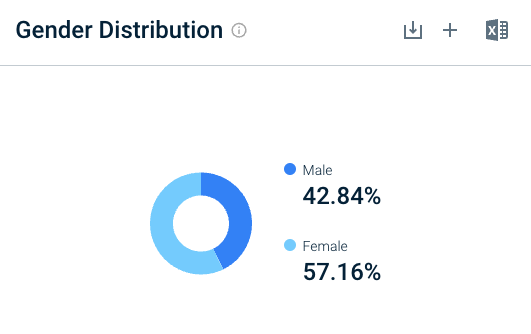
As a bald male, I had to confront my own biases that initially made me overlook a significant demographic. To make the most of this exercise, it’s crucial that you don’t let your personal biases cloud your judgment.
In light of my realization, I did create a mind map for the male audience, following the same steps. However, to avoid repetition, I won’t detail that process again.
Always remember: diversity in perspectives can enrich your content strategy!
Step 3: Find The Data To Support Ideas
This is where the fun begins! I simply take all the questions I’ve brainstormed in my mind map and pop them into Google to see what surfaces.
If you take a look at the screenshot below, you’ll see that my initial search query doesn’t have any search volume (highlighted in the red box).
Despite this, Google still fetches a bunch of relevant results. Interestingly, each of these results does rank for a certain number of keywords, as indicated by the green boxes.
So, even without search volume for the initial query, there’s still relevant content out there capturing people’s interest.
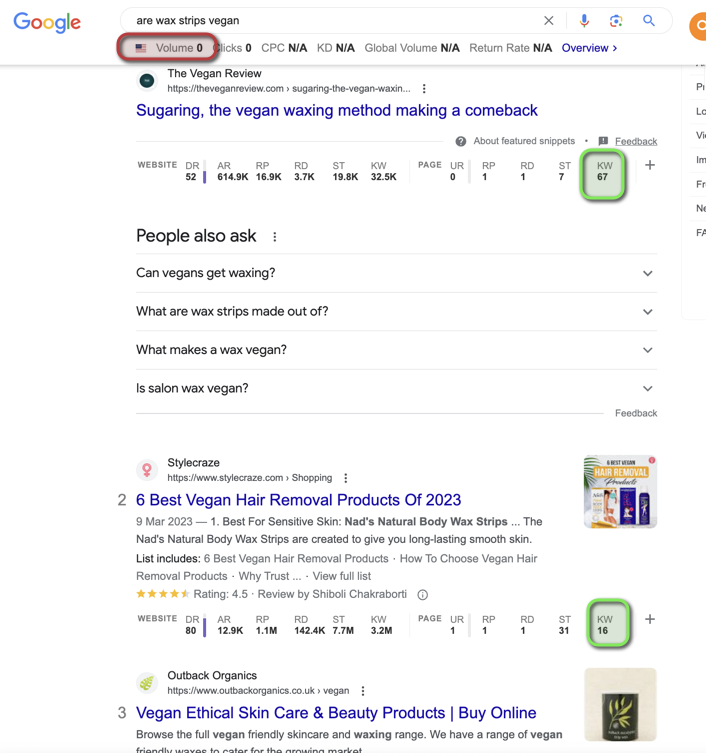 Screenshot for search for [are wax strips vegan], Google, May 2023
Screenshot for search for [are wax strips vegan], Google, May 2023
You’re going to want to gather all these keywords. Honestly, this is where I find the Ahrefs toolbar to be a gem.
It allows me to click on each search result and conveniently export the keywords associated with each one. This makes the whole process much more streamlined and efficient.
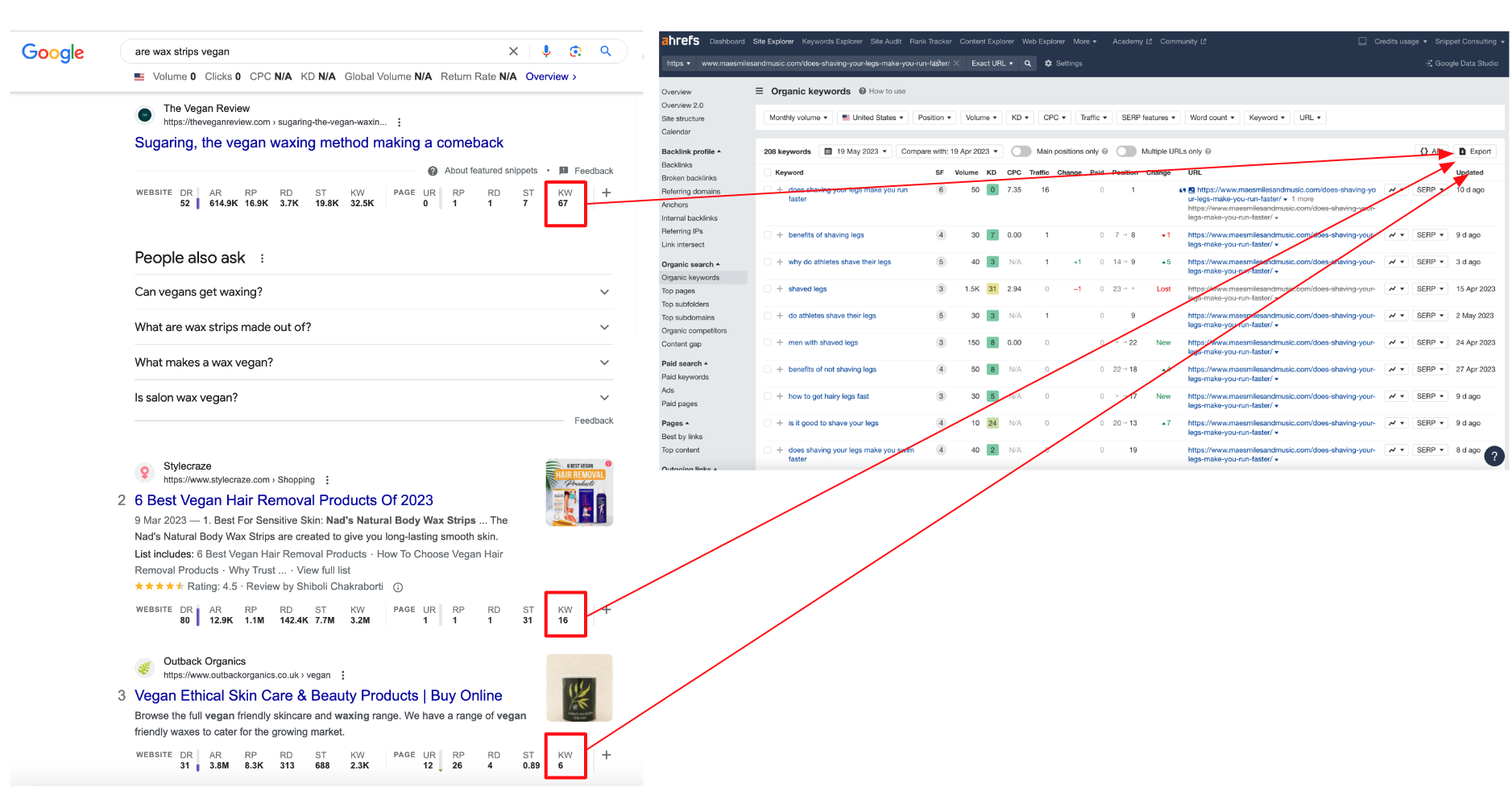
Of course, you don’t need Ahrefs for this; there are other great tools to get the keywords for each URL. I just find the toolbar incredibly useful here.
Step 4: Rinse And Repeat With Each Of Your Content Ideas
You’ll want to enter each of your ideas into Google and get all the keywords for the articles that rank – even if your original query had no search volume.
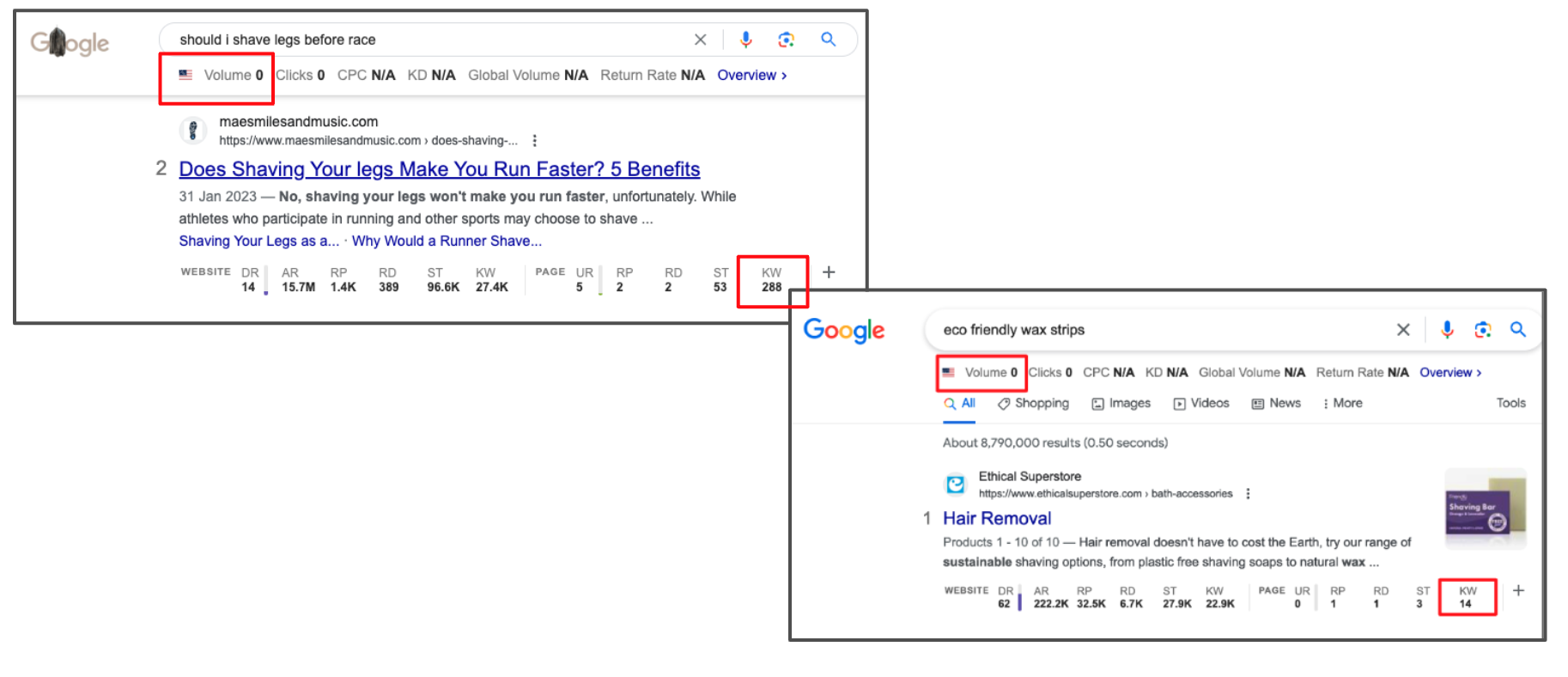
Step 5: Find Additional Keywords None Of Your Competitors Will Have
At this point, you should have a list of keywords that are tangentially related to your target brand.
These keywords correspond to the questions and pain points of your buyer persona, providing a strong foundation for content that’s relevant and engaging for your target audience.
But because you’ve downloaded these keywords from an SEO tools database, your competitors have them, too.
They may not be your direct competitors, but someone has them (otherwise, we wouldn’t have been able to get them from the SEO tool).
So how do we get the keywords no one has? We need to seek additional sources of inspiration.
I generally turn to forums or late UGC sites. Why? Dynamic forums like Reddit and Quora have a huge user base, all of whom are asking questions that many of them can’t find the answers to elsewhere online.
On forums like Reddit, we can zero in on specific topics and subreddits to surface popular questions that get a lot of engagement.
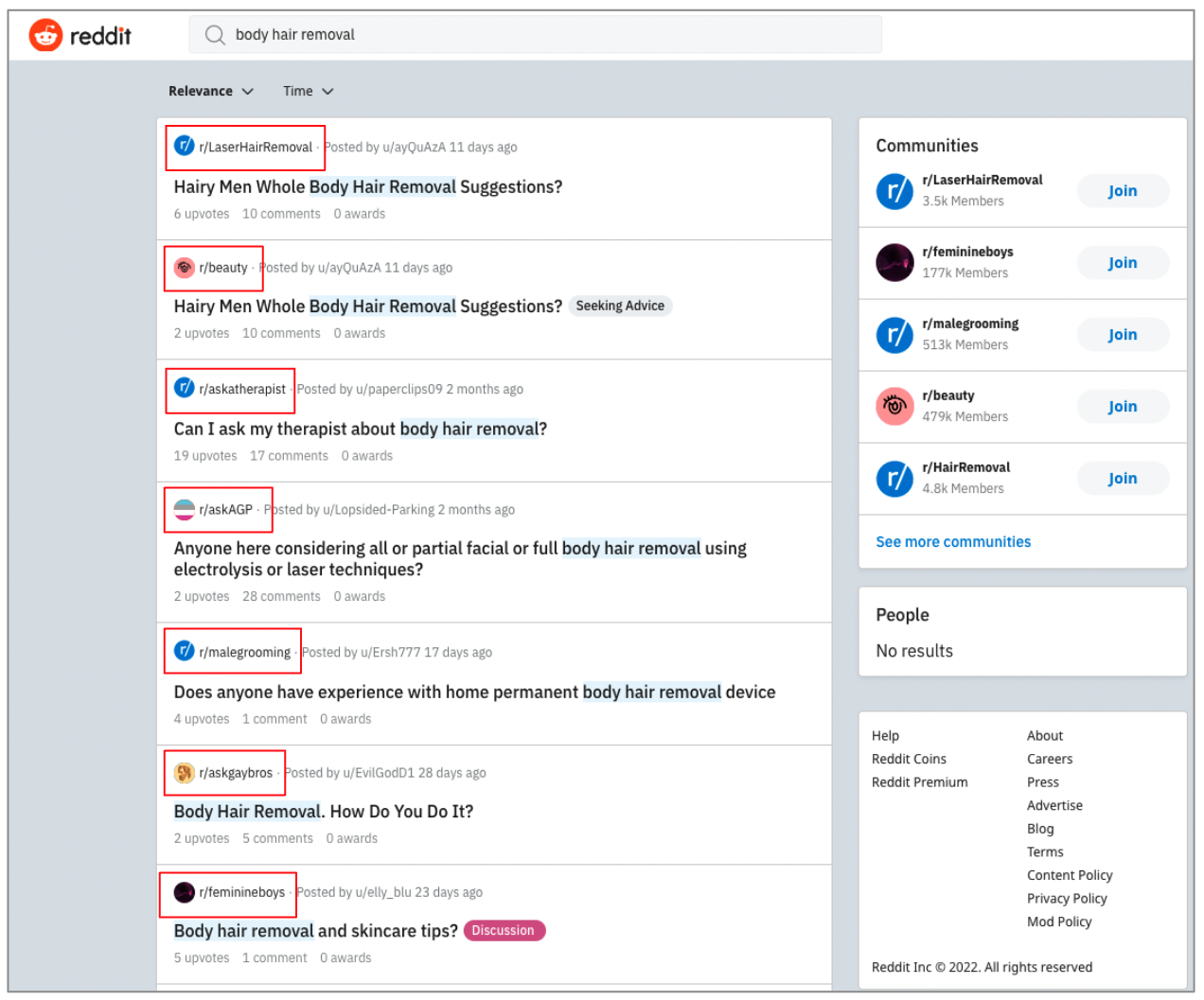 Screenshot from Reddit, May 2023
Screenshot from Reddit, May 2023
Keep in mind that many individuals resort to forums to seek answers to questions that the internet doesn’t readily provide.
On user-generated content (UGC) sites, the same question can be phrased in countless ways, which means conventional keyword tools might not capture this diversity.
Now, if you find a slew of keywords phrased differently but asking the same question, all registering as “zero volume” yet showing substantial engagement (in the form of likes, upvotes, shares, etc.), can we truly label them as zero volume?
I’d argue most certainly not. There’s clearly an active interest and engagement there, and that’s what truly matters.
Back to our hair removal example. There were also thousands of unanswered questions and ideas on Quora.
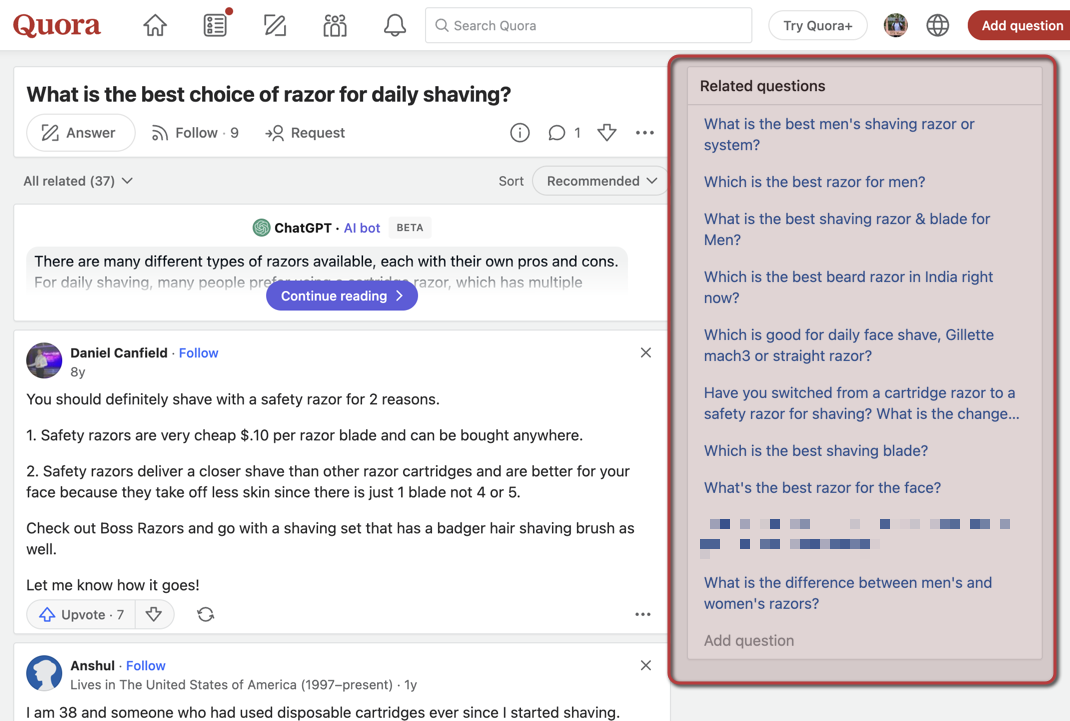 Screenshot from Reddit May 2023
Screenshot from Reddit May 2023
Anyway, we want all these “keywords” too.
The easiest and quickest way is to make a little scraper that searches for keywords and pulls all these. There are plenty of Python libraries for the more “well-known” forums, like this one for Quora and this guide for Reddit.
If you’re not inclined towards coding, don’t have the skills, or perhaps the niche you’re exploring doesn’t readily present good ideas on major forums, there’s a solution for you.
Chrome extensions like Scraper are excellent tools for this. You can simply right-click and use it to scrape all the relevant questions.
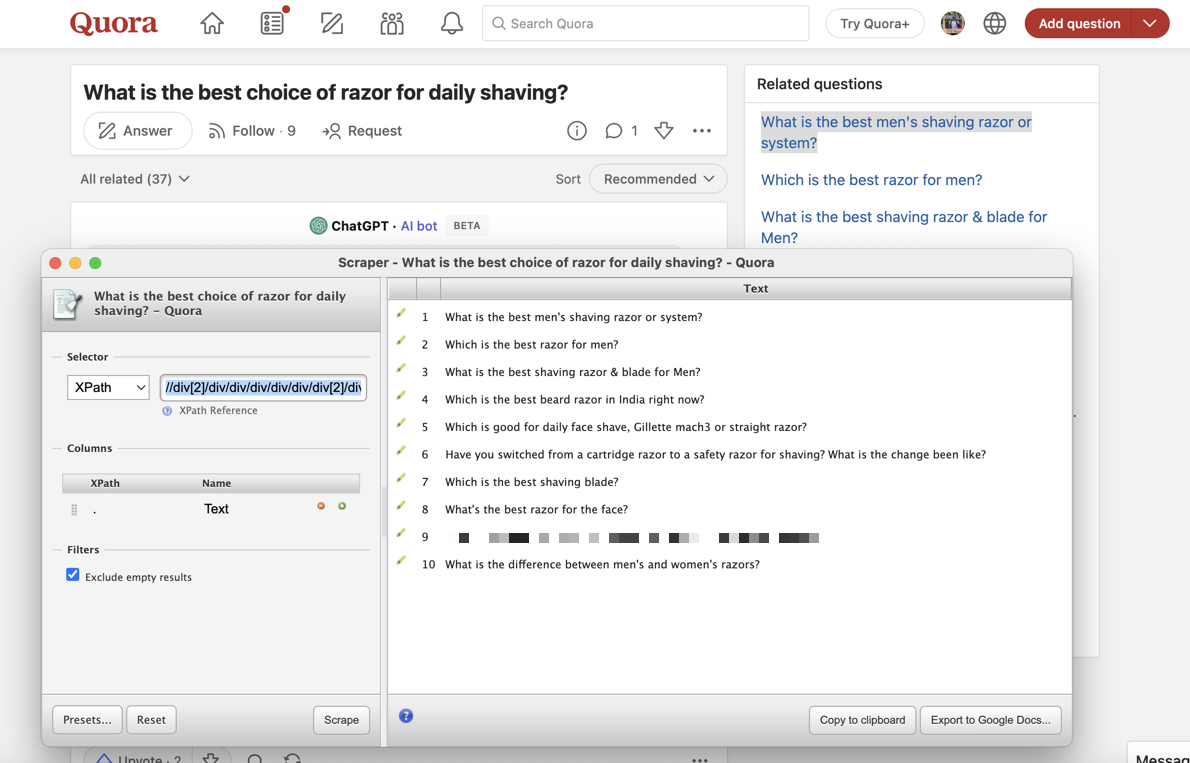 Screenshot from Quora May 2023
Screenshot from Quora May 2023
Step 6 (Optional): Use AI To Make The Questions Less “Chatty”
Of course, when people ask questions on forums, they word them in weird, colloquial ways with misspellings and local abbreviations. We can use ChatGPT here again to make all of our scraped questions “less chatty.”
Use the following prompt to make them more readable:
“Reword the following Reddit questions and reword them into a simple question. Please present the results in a table”
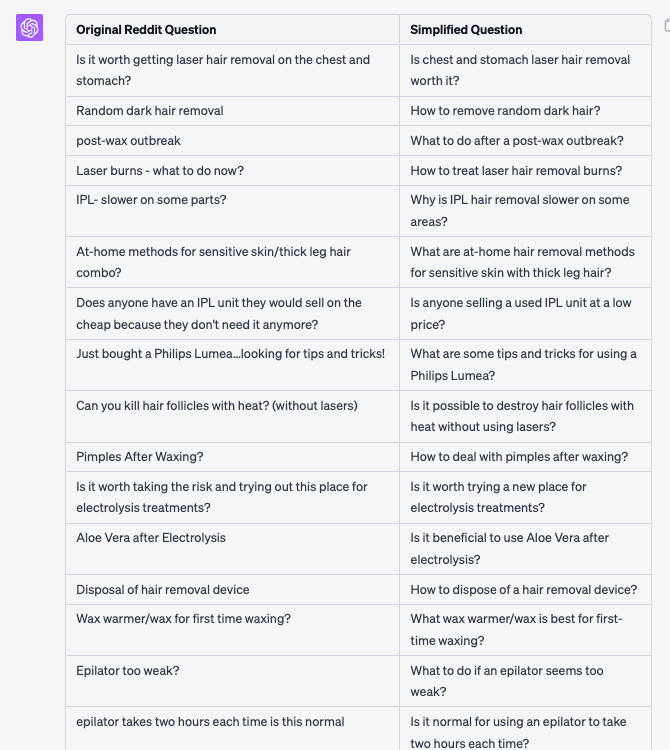 Screenshot from ChatGPT, May 2023
Screenshot from ChatGPT, May 2023
This particular example isn’t the most exciting I’ve ever encountered, as all the questions sort of made sense in their original state without the AI.
Reflecting back again on the time we did this exercise for the condom brand, the quirks were countless. We had a plethora of strange abbreviations and peculiar phrasings, and the AI’s knack for “translating” these into coherent questions was incredibly beneficial.
Step 7 (Optional): Get All The Related Questions, Too
Once I’ve got all my forum questions, normalized or not (this step still works without using AI to make the questions more “sensical”), I like to get all the related questions too.
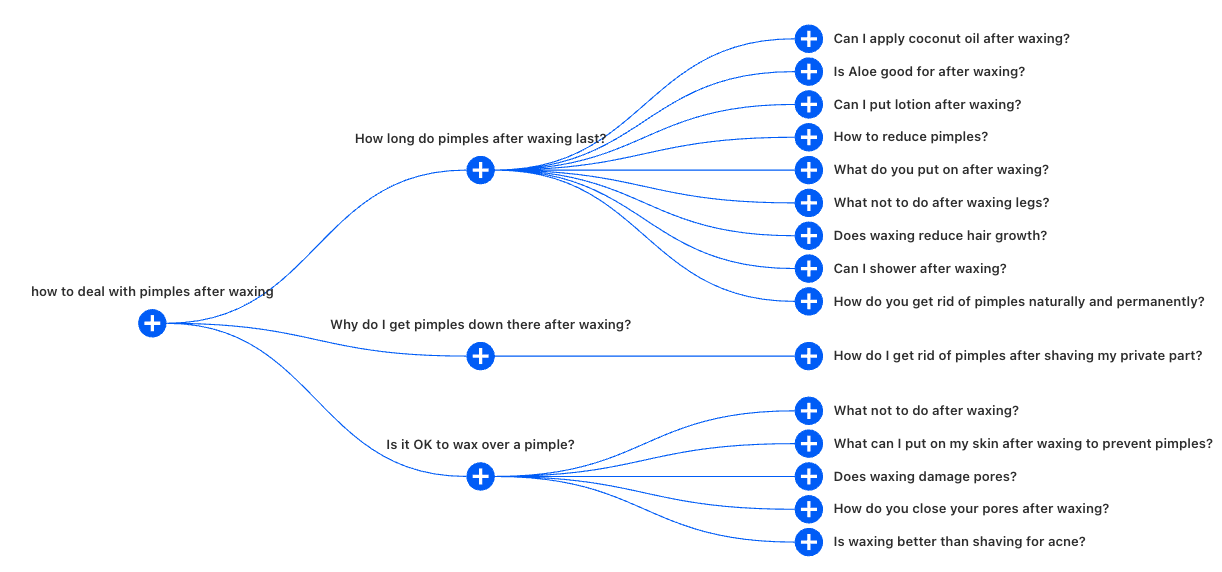 Screenshot from People Also Asked May 2023
Screenshot from People Also Asked May 2023
There are plenty of tools and ways to scrape these for every keyword in your dataset. I personally like to use People Also Asked, as you can bulk upload to it.
Step 8: Get The Search Volumes For All Your New Queries
The keyword data you’ve downloaded from your go-to SEO tools like Ahrefs and Semrush will already include search volumes, so there’s no need to fuss over those.
However, all the fresh queries that you’ve discovered should also be plugged into an SEO tool to check if they hold any search volume.
This batch includes any of the keywords you extracted (and potentially standardized using AI), as well as any related People Also Ask questions that surfaced during your research.
Don’t worry if many of the queries show no volume; in fact, that’s to be expected. As we’ve already touched on, you’ll notice the same question is frequently asked, just worded in a variety of different ways.
Pair that with the fact that many of these questions tend to gather significant engagement on social platforms, and you’ll realize these so-called “zero volume” keywords aren’t truly “zero volume.”
To spot these repeating questions, we need a quick way to group similar queries together.
Step 9: Cluster Your Keywords
Grouping keywords together, or clustering, helps us organize our data. It turns a potentially overwhelming list of keywords into smaller, more manageable groups.
By clustering keywords, we can better understand which pages to create and pinpoint recurring questions within those elusive “zero volume” keywords.
There are many keyword clustering tools out there, but ensure you use one which clusters keywords by the search engine results and not natural language processing.
The former ensures you’re grouping keywords based on how a search engine understands them, not a language model.
Most clustering tools require you to upload a single CSV, meaning you may have to go through and combine all your reports at this stage. If all the columns match up, you could use an online CSV merging tool like this.
Remember to de-duplicate the keywords, too, so that you don’t have double data in there.
If you opt for Keyword Insights as your clustering tool, it offers you the freedom to upload any number of CSVs, regardless of whether the columns align.
The tool will guide you in mapping out the columns. Additionally, it conveniently de-duplicates the keywords for you.
(Disclosure: I am one of the co-founders of Keyword Insights, but there are many other great clustering tools out there).
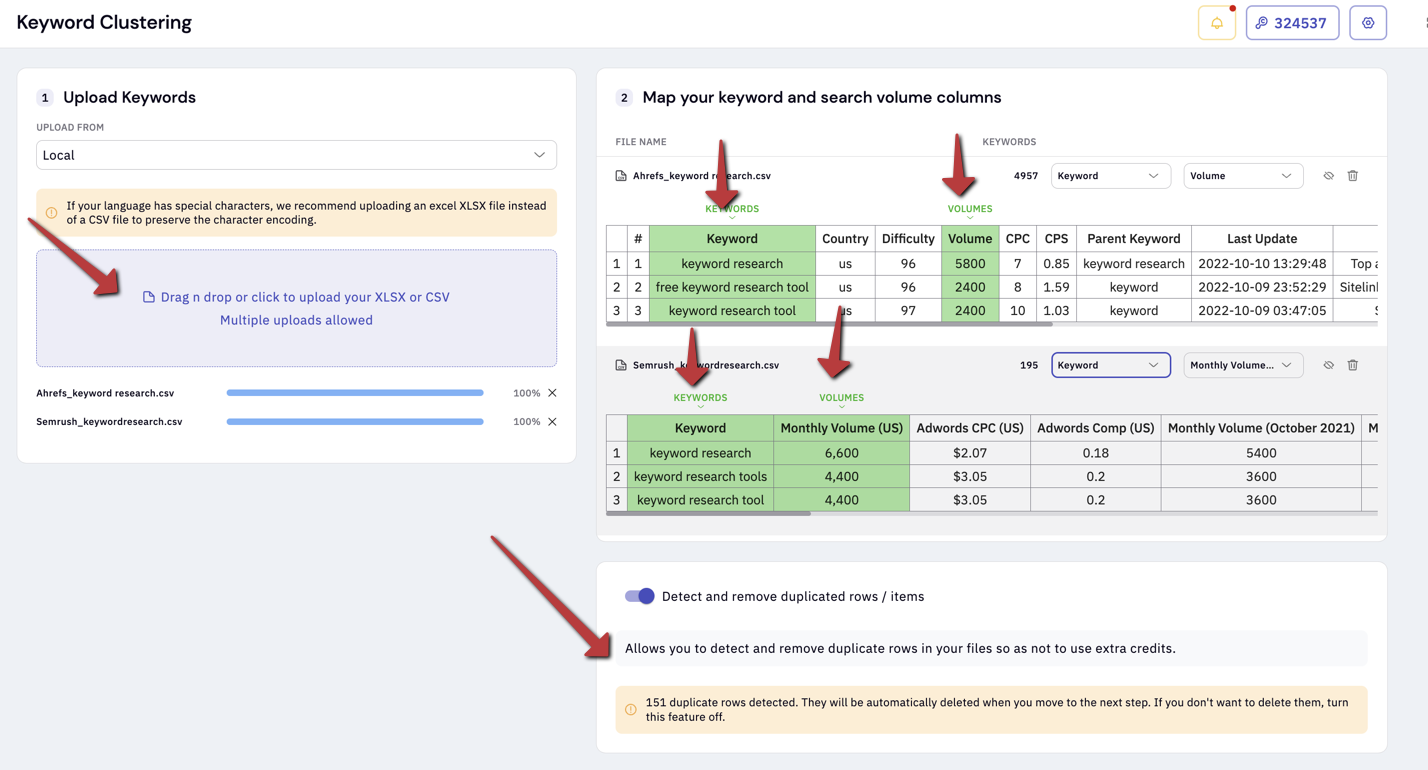 Screenshot from Keyword Insights, May 2023
Screenshot from Keyword Insights, May 2023
Once you have your clustering report ready, you’ll start noticing the trends I mentioned earlier. For instance, observe the number of queries around variations of “Can you recycle razor blades?”
Traditional keyword research might overlook this term because other SEO tools reported it as having only “60 monthly searches.” However, the total sum of all similar questions asked is likely much higher.
Also, keep in mind these “zero volume” queries were selected based on the engagement they garnered (likes, shares, comments, etc.). So, they’re undoubtedly relevant topics to address.
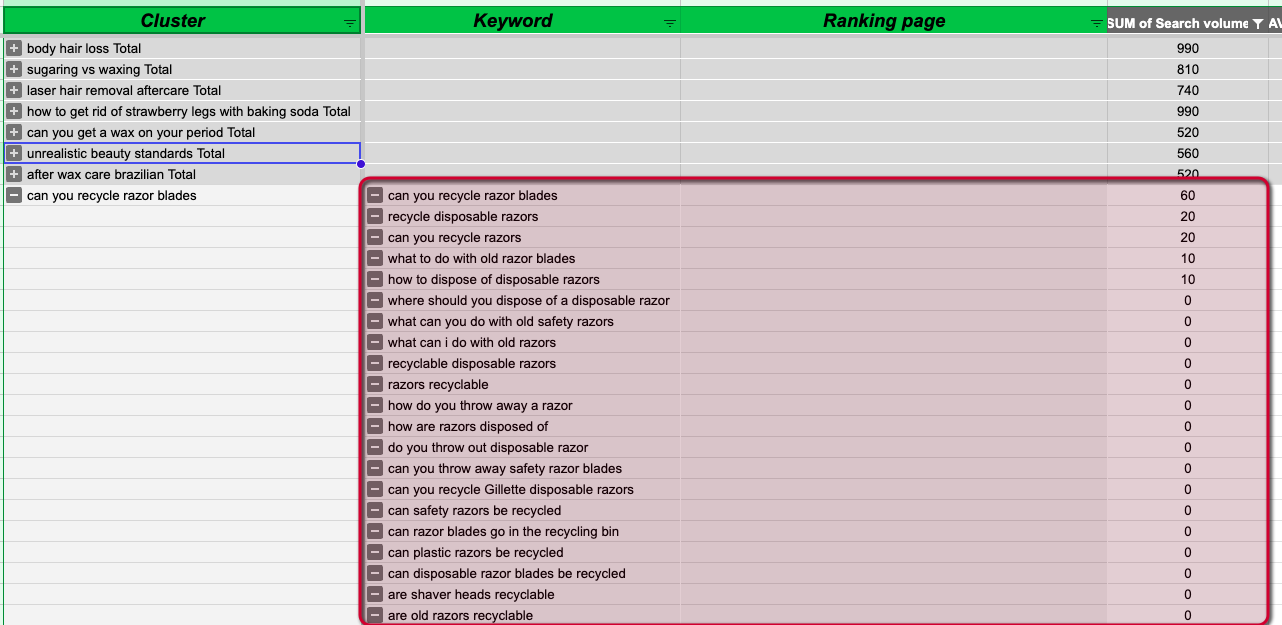 Screenshot from Keyword Insights, May 2023
Screenshot from Keyword Insights, May 2023
Example Insights
After following the above steps for a hypothetical hair removal company, I found myself with a pool of 12,590 keywords, which could be organized into 975 clusters.
Below are some insights we could potentially highlight, confident in the knowledge that it’s likely our competitors haven’t addressed some, if not most, of these topics.
Pre-Purchase
There were many obvious clusters of questions that hadn’t been answered about what potential users were asking before they waxed or around alternative methods of waxing. For example:
 Screenshot from Keywords Insights May 2023
Screenshot from Keywords Insights May 2023
Here’s another example:
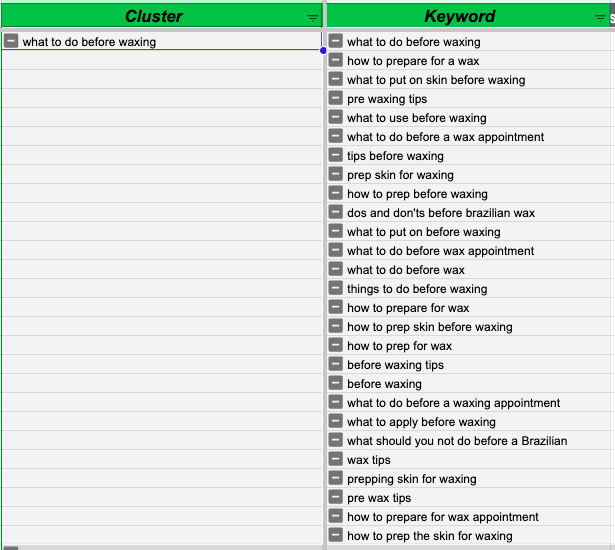 Screenshot from Keyword Insights, May 2023
Screenshot from Keyword Insights, May 2023
Look at how diverse the wording of the same question is. There’s likely a lot more search volume to the query “what to do before waxing” than SEO tools are reporting.
Post-Purchase
It’s quite uncommon to see brands excel in creating “post-purchase” content. “Post-purchase content” refers to valuable materials designed to assist their customers after they’ve already utilized their products (or similar ones).
Creating high-quality post-purchase content is a valuable strategy for any business. It demonstrates a sustained commitment to your customers beyond the point of purchase.
By providing this kind of support, you’re nurturing a relationship that extends beyond the transaction, reinforcing that your brand truly cares about their experience.
Moreover, this approach can potentially decrease the volume of customer service queries as you’re proactively addressing common questions and concerns. This not only streamlines your operations but also enhances the customer’s experience with your brand.
One such large cluster I came across that a hair removal company might wish to cover is this one:
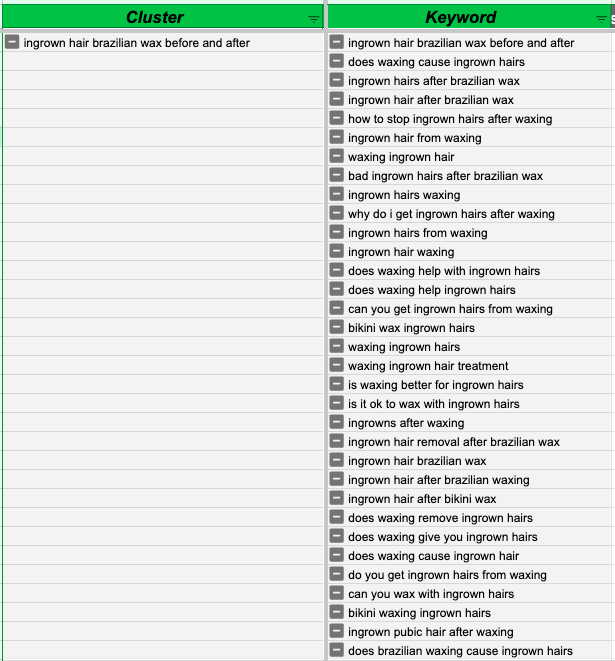 Screenshot from Keyword Insights, May 2023
Screenshot from Keyword Insights, May 2023
Investigating the issue of “ingrown hair after waxing” can bring significant advantages for a hair removal brand.
Let’s explore why.
Firstly, individuals are continuously in search of solutions. The aftermath of waxing isn’t always smooth; dealing with ingrown hairs can be challenging. If your brand can offer relevant and effective advice, it positions you as a trusted expert in the field.
Moreover, consider those online users who are seeking advice for their ingrown hairs. While they may not be actively searching for hair removal products at the moment, if they come across an informative article from your brand, they’ve just made a connection with you.
Essentially, you’ve expanded your reach to prospective customers who were previously unknown.
For your existing customers, providing such value-added content strengthens your relationship. You’re not just a vendor selling them products, but a trusted adviser, enhancing their loyalty to your brand.
From a technical standpoint, producing consistent, quality content increases your visibility to search engines, potentially improving your search rankings. Furthermore, you may gain additional backlinks and social shares, furthering your reach and visibility.
Lastly, offering knowledgeable advice on a topic that is indirectly related to your product underscores your understanding and expertise in the broader field.
You’re not just a product seller; you’re an active participant in the ongoing dialogue, which can enhance your brand’s credibility and influence.
Lifestyle And Advice
The research found a ton of ideas that would resonate with our target audience’s lifestyle needs.
Remember, we’re selling products to real people with real problems. If there’s any content that can help them, even if it’s only “tangentially related” to what we sell, it’s in our best interest to produce it.
Here are some examples:
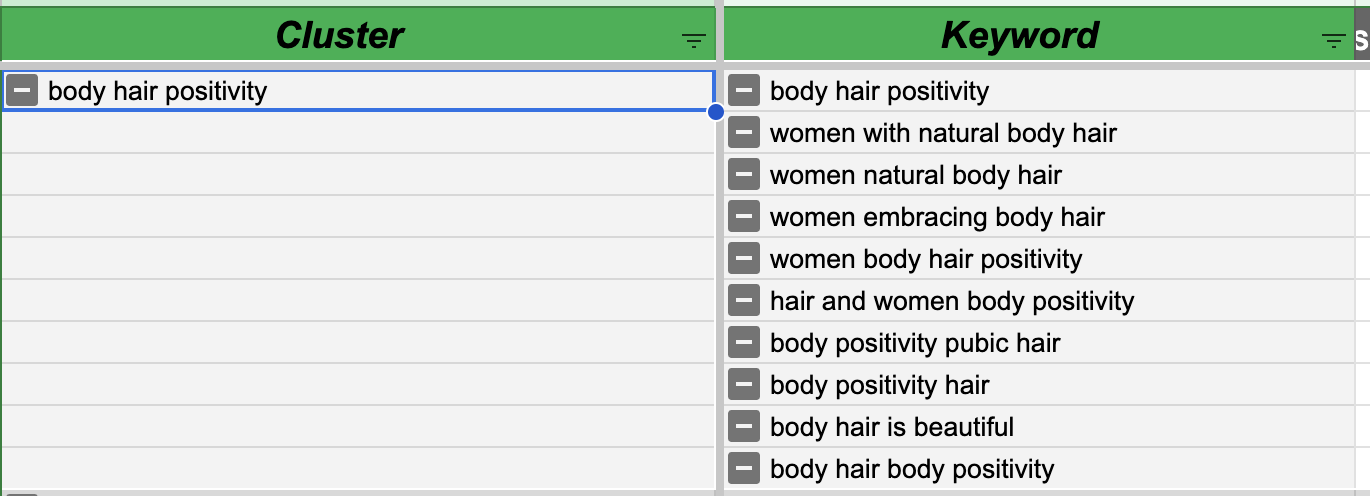 Screenshot from Keyword Insights, May 2023
Screenshot from Keyword Insights, May 2023
Promoting body positivity can offer a strategic advantage for a hair removal brand. From a psychological perspective, it fosters self-acceptance and challenges negative beauty norms, reducing body-related anxiety among consumers. This approach can encourage healthier behaviors, reduce harmful social comparisons, and cultivate resilience against societal pressures, all while promoting inclusivity and a sense of value regardless of physical appearance. The indirect influence on sales could be substantial: by aligning the brand with a cause that resonates with many consumers, it may enhance brand perception and customer loyalty. Consequently, customers may prefer to buy from a brand that genuinely aligns with their values, leading to increased sales and stronger brand loyalty. Nevertheless, the brand’s values must be communicated authentically for the impact to be truly meaningful.
Similar ideas include:
 Screenshot from Keyword Insights, May 2023
Screenshot from Keyword Insights, May 2023
And:
 Screenshot from Keyword Insights, May 2023
Screenshot from Keyword Insights, May 2023
Along with:
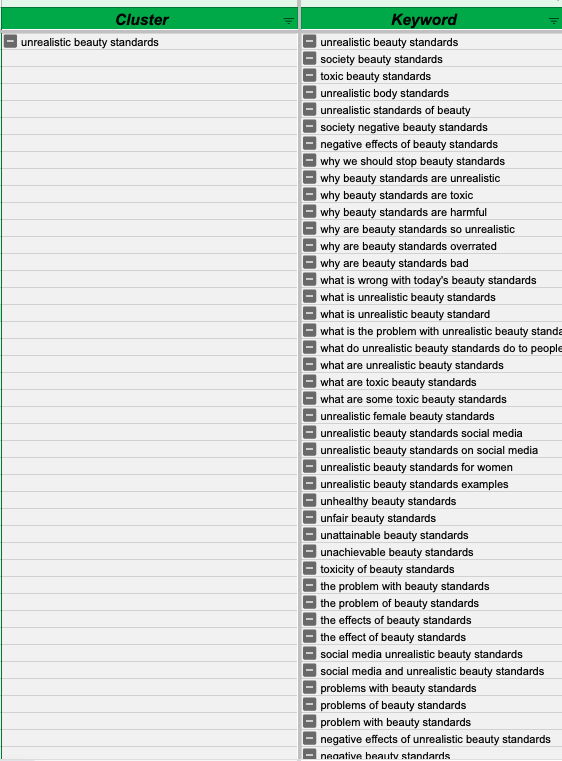 Screenshot from Keyword Insights, May 2023
Screenshot from Keyword Insights, May 2023
By engaging in this broader conversation about attractiveness, the brand can connect more deeply with its audience and demonstrate an understanding of their concerns, thus building trust and strengthening customer relationships.
New Product Ideas
As I mentioned at the beginning, when you explore various topics for your tangential content, it’s more than just collecting ideas for upcoming posts.
You’re actually delving deeper into your customers’ needs and interests that haven’t been addressed yet. This valuable insight can potentially steer the direction for the creation of new products.
We’ve already seen numerous examples of questions people were asking about societal expectations and beauty standards surrounding body hair. It’s natural, therefore, for men to seek out suitable products for addressing these concerns:
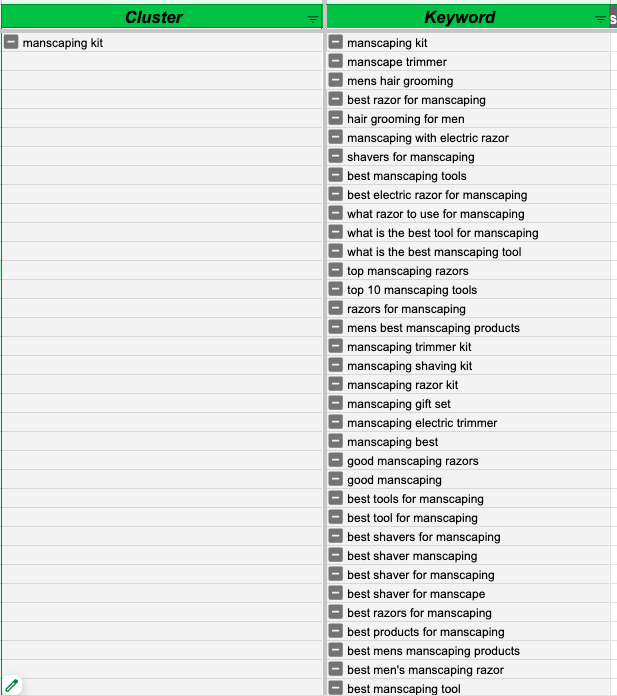 Screenshot from Keyword Insights, May 2023
Screenshot from Keyword Insights, May 2023
Including:
 Screenshot from Keyword Insights, May 2023
Screenshot from Keyword Insights, May 2023
Cast your mind back to the buyer persona we created. One of the key values our person has is being “environmentally friendly.”
It’s great, therefore, that our research has surfaced many potential new product ideas that align with this:
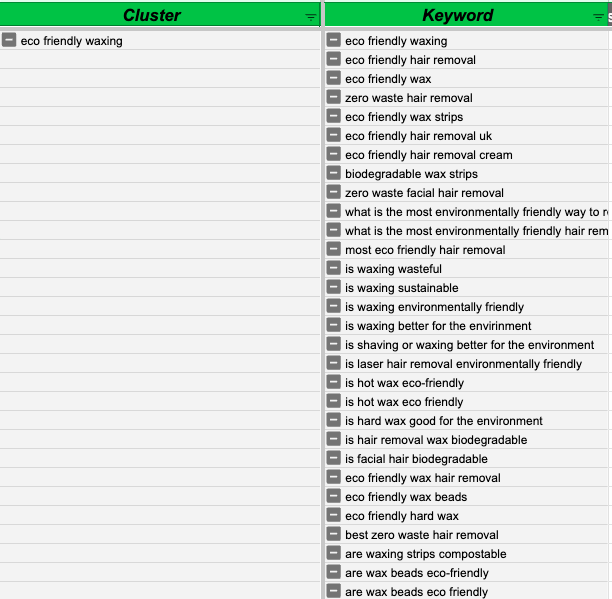 Screenshot from Keyword Insights, May 2023
Screenshot from Keyword Insights, May 2023
Of course, these are just a few samples of what I found. Across the 975 clusters in my research, there were loads of new content and product ideas.
Conclusion
It’s crucial for brands to incorporate tangential keyword research into their strategies in order to stay relevant and connect with a wider audience.
By exploring related topics and keywords, brands can uncover new opportunities, engage diverse audiences, and establish themselves as industry leaders.
Tangential keyword research enables brands to identify emerging trends, understand unique customer needs, and develop innovative content and products that resonate with their target market.
Embracing tangents allows brands to outshine competitors, foster customer loyalty, and achieve long-term success in today’s fast-paced digital landscape.
To discover tangential ideas, follow these steps:
Understand your target consumer: Put yourself in their shoes and identify the type of content and questions they may have that are tangentially relevant to your business. Explore existing content: Check if any content already addresses these concerns. Use your preferred SEO tool to extract ranking keywords by entering relevant URLs. Enrich your tangential content ideas: Uncover unique keywords that your competitors may not have discovered. Seek inspiration beyond traditional sources of keyword research on forums or social media platforms where people ask questions that aren’t adequately answered elsewhere online. Cluster your keywords: So that you more easily spot patterns and add “volume” to these technically “zero volume” keywords, the keywords need to be grouped together. Analyze clusters for trends: Categorize your insights into main categories, such as pre-purchase, post-purchase, new product ideas, lifestyle, and advice. This will help you identify interesting trends and capitalize on them effectively.In the practical example, we gathered a significant portion of our keyword ideas by scraping Reddit and Quora.
It’s important to note that not all niches can benefit from these channels (for instance, a website selling broadband cables is unlikely to find much insight there).
However, rest assured that there is always a forum or social channel available for every niche; the key lies in discovering it.
Happy keyword hunting.
More resources:
How To Use ChatGPT For Keyword Research Keyword Clusters: How to Level up Your SEO Content Strategy 16 Best Keyword Research Tools For SEOFeatured Image: REDPIXEL.PL/Shutterstock

 Tfoso
Tfoso 

































